
MEETTHEBUKHARA DEEROF HIGHLAND WILDLIFEPARK



MEETTHEBUKHARA DEEROF HIGHLAND WILDLIFEPARK

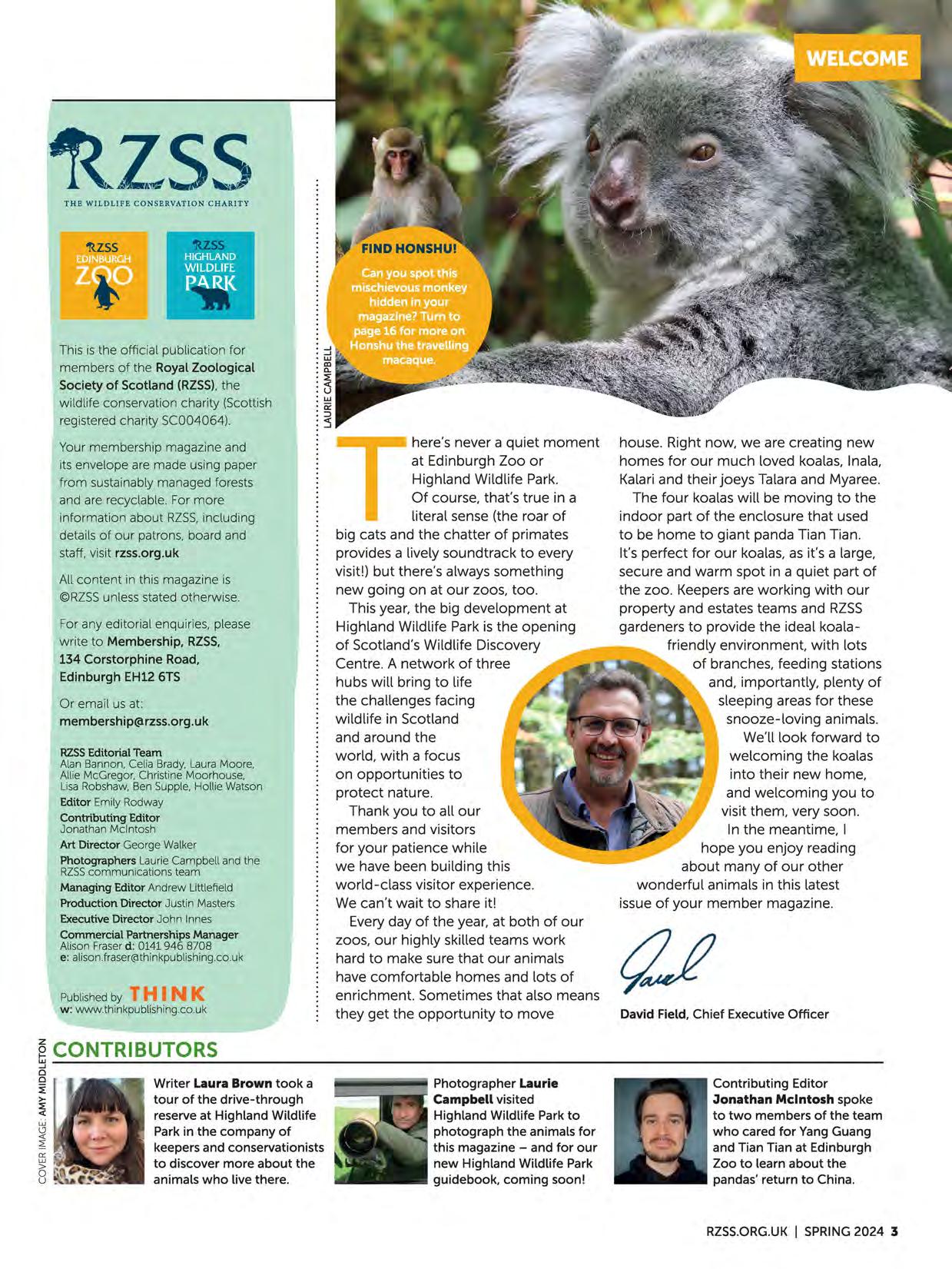
This is the official publication for members of the Royal Zoological Society of Scotland (RZSS). the wildlife conservation charity (Scottish registered charity SC004064).
Your membership magazine and its envelope are made using paper from sustainably managed forests and are recyclable. For more information about RZSS,including details of our patrons, board and staff, visit rzss.org.uk
All content in this magazine is ©RZSS unless stated otherwise.
For any editorial enquiries. please write to Membership, RZSS, 134 Corstorphine Road, Edinburgh EH12 6TS
Or email us at: membership@rzss.org.uk
RZSSEditorial Team
Alan Bannon, Celia Brady, Laura Moore, Allie McGregor, Christine Moorhouse, Lisa Robshaw, Ben Supple, Hollie Watson
Editor Emily Rodway
Contributing Editor Jonathan McIntosh
Art Director George Walker
Photographers Laurie Campbell and the RZSScommunications team
Managing Editor Andrew Littlefield
Production Director Justin Masters
Executive Director John Innes
Commercial Partnerships Manager Alison Fraser d: 0141 946 8708 e: alison.fraser@thinkpublishing.co.uk
Published by T H I N K w: wwwthinkpublishing.co.uk
There's never a quiet moment at Edinburgh Zoo or Highland Wildlife Park. Of course, that's true in a literal sense (the roar of big cats and the chatter of primates provides a lively soundtrack to every visit!) but there's always something new going on at our zoos, too.
This year, the big development at Highland Wildlife Park is the opening of Scotland's Wildlife Discovery Centre. A network of three hubs will bring to life the challenges facing wildlife in Scotland and around the world, with a focus on opportunities to protect nature.
Thank you to all our members and visitors for your patience while we have been building this world-class visitor experience. We can't wait to share it!
Every day of the year, at both of our zoos, our highly skilled teams work hard to make sure that our animals have comfortable homes and lots of enrichment. Sometimes that also means they get the opportunity to move
house. Right now, we are creating new homes for our much loved koalas, lnala, Kalari and their joeys Talara and Myaree. The four koalas will be moving to the indoor part of the enclosure that used to be home to giant panda Tian Tian. It's perfect for our koalas, as it's a large, secure and warm spot in a quiet part of the zoo. Keepers are working with our property and estates teams and RZSS gardeners to provide the ideal koalafriendly environment, with lots of branches, feeding stations and, importantly, plenty of sleeping areas for these snooze-loving animals. We'll look forward to welcoming the koalas into their new home, and welcoming you to visit them, very soon. In the meantime, I hope you enjoy reading about many of our other wonderful animals in this latest issue of your member magazine.
David Field, Chief ExecutiveOfficerContributing Editor Jonathan McIntosh spoke to two members of the team who cared for YangGuang and Tian Tian at Edinburgh Zoo to learn about the pandas'return to China.
THE WILDLIFE CONSERVATION CHARITYYour membership
Enjoygreat daysout at EdinburghZoo and Highland Wildlife Parkas often as you like, plus...

Discounted admission for your family and friends who accompany you on your day out to Edinburgh Zoo and Highland Wildlife Park.
Regular updates via our member emails -contact membership@rzss.org.uk or sign up on our website at rzss.org.uk/memberemail
Discounts in our cafes, restaurants and gift shops. Don't forget to show your membership card to our friendly teams.
Free parking at Edinburgh Zoo. Remember to get your ticket validated at the members gate or admissions when you arrive.
7 Photography competition
Have you taken an amazing photo of one of our animals on your most recent visit?
8 Conservation champions
Help to save the animals you love
12 The big picture
The Amur tigers of Highland Wildlife Park
14 Latest news from our parks
18 Conservation updates
20 Family trees
Polar bears, chimps and penguins at Edinburgh Zoo and Highland Wildlife Park
22 Ajourneyto China
How we said goodbye to Yang Guang and Tian Tian
28 Day in the life of Animal Antics
Have you seen our amazing daily shows?
30 Living side by side
There's so much to discover at Highland Wildlife Park's drive-through reserve
36 A remarkable career
Roger Wheater looks back at his decades with Edinburgh Zoo and RZSS
40 Northern rockhopper penguins
Seven facts about these residents of Penguins Rock
42 Saving the bloodsuckers
Why we're helping to restore Scotland's populations of medicinal leeches
46 Member guide
Events for the whole family to enjoy
48 In the shops
Sustainable gifts new to our parks this spring
SO A moment I'll never forget
Senior keeper Andrew Laing on making the introductions between two Sumatran tigers
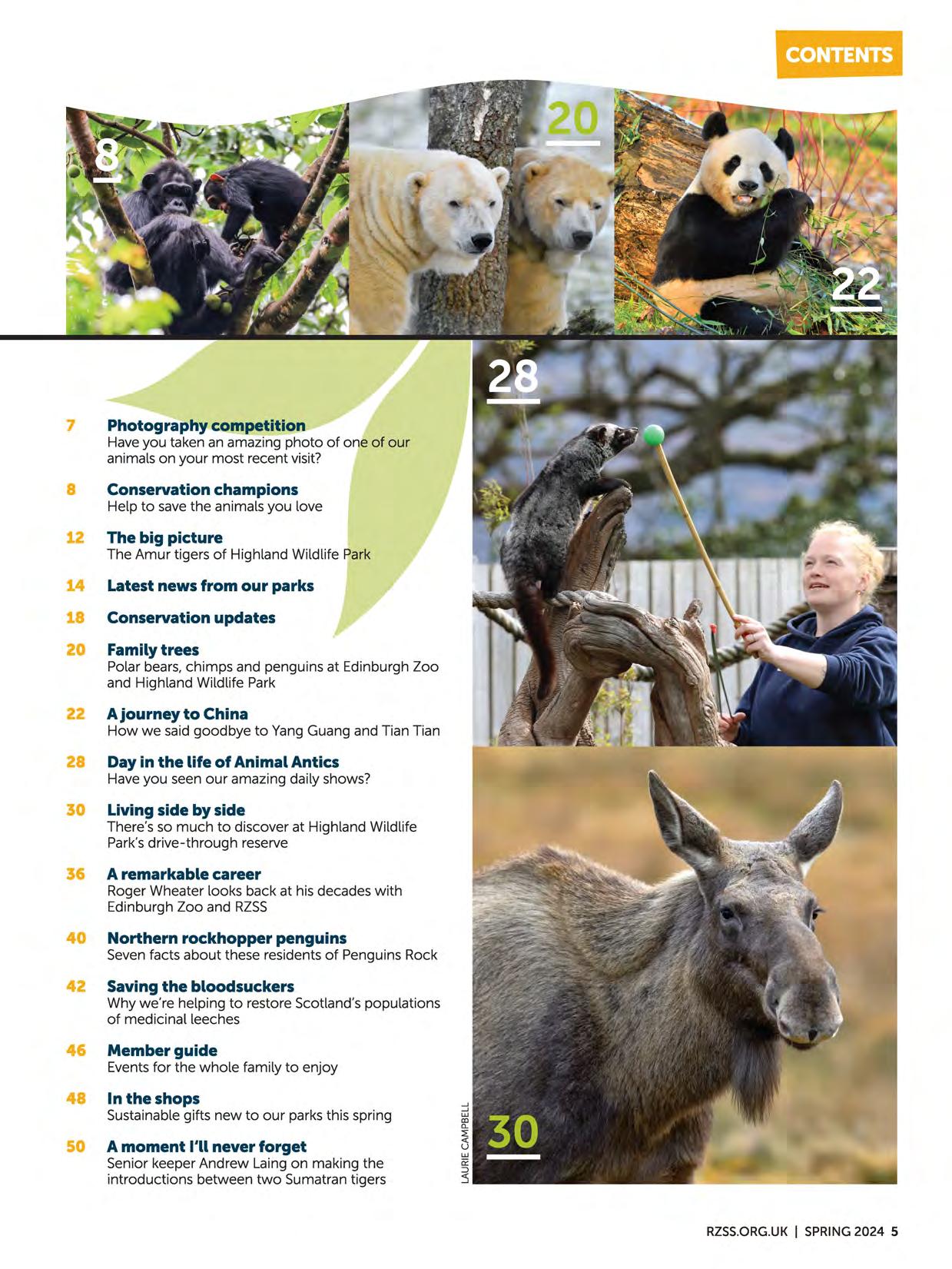

We know that many of our members love taking photographs of the animals at Edinburgh Zoo and Highland Wildlife Park. Now your beautiful images could win you a prize!
We will be selecting two overall winners; one in the adult category (aged 16 or over) and one in the junior category (aged 8 to 15) as well as a selection of runners-up. The 12 winning photographs will then be printed in the 2025 RZSScalendar!
We are delighted that Scotland's leading natural heritage photographer, Laurie Campbell (bottom left), has agreed to help judge our new photography competition. As well as taking many of the incredible photographs you see in this magazine, Laurie also leads the wildlife
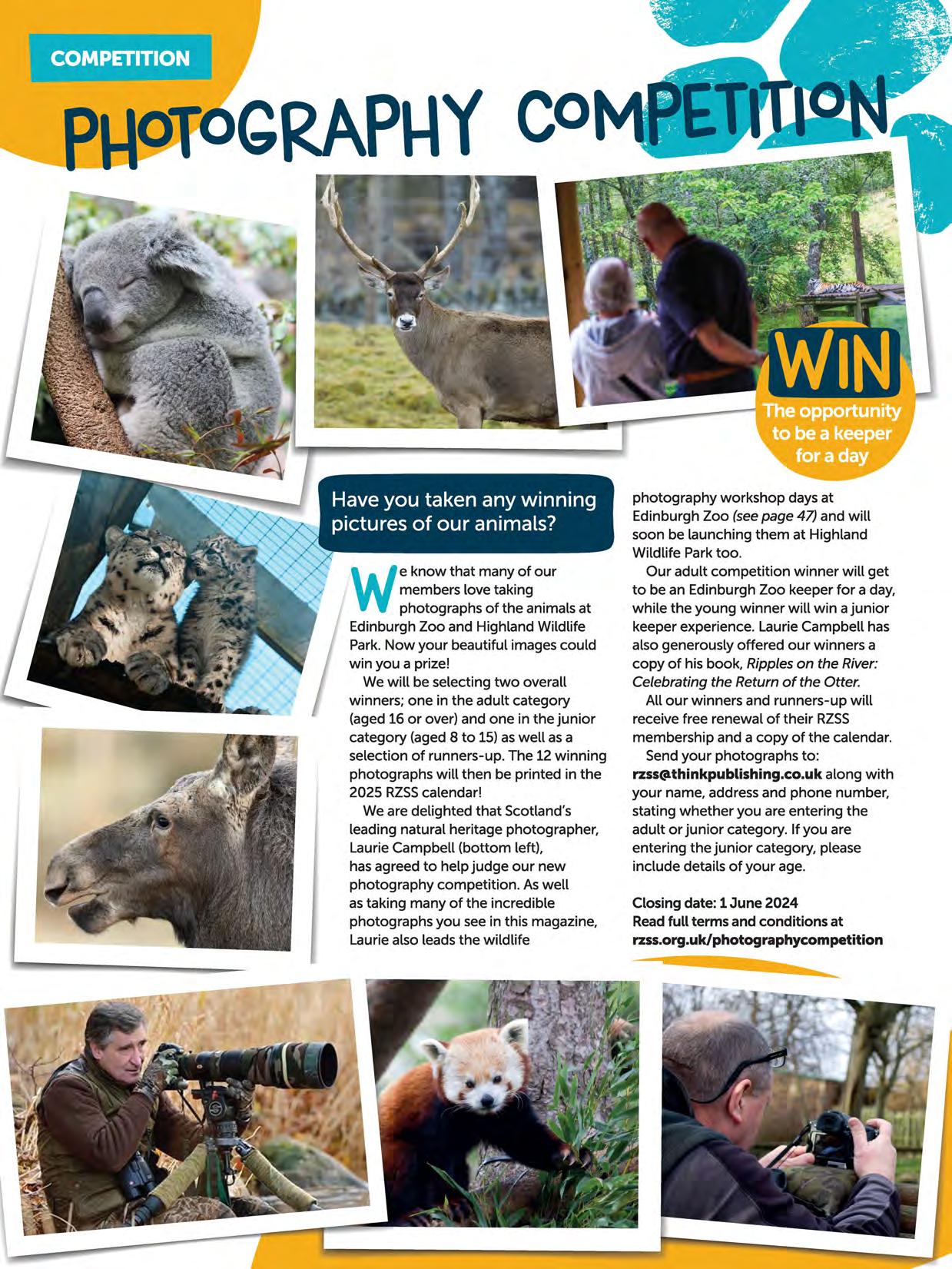
photography workshop days at Edinburgh Zoo (see page 47) and will soon be launching them at Highland Wildlife Park too.
Our adult competition winner will get to be an Edinburgh Zoo keeper for a day, while the young winner will win a junior keeper experience. Laurie Campbell has also generously offered our winners a copy of his book, Ripples on the River: Celebrating the Return of the Otter.
All our winners and runners-up will receive free renewal of their RZSS membership and a copy of the calendar.
Send your photographs to: rzss@thinkpublishing.co.uk along with your name, address and phone number, stating whether you are entering the adult or junior category. If you are entering the junior category, please include details of your age.
Closingdate: 1 June 2024
Readfull terms and conditionsat rzss.org.uk/photographycompetition
hanks to support from members and donors, RZSShas helped to protect chimpanzees in Uganda's Budongo Forest for nearly 20 years. Sadly,these endangered chimpanzees face many threats, including the destruction of their forest home and wire snares set by poachers, which are particularly dangerous for juvenile chimps.
Our charity works in partnership with Budongo Conservation Field Station (BCFS).Ugandan staff employed by BCFSmonitor the chimpanzees' health, remove deadly snares and treat injured

animals, as well as overseeing other complex work to benefit the chimps, other local wildlife and people living in the area. Conservation expertise is shared between our two organisations for the benefit of species in both our countries and around the world.
''The rangers know everything about the individual animals"
Helen Senn, Head of Conservationand ScienceProgrammes
For Helen Senn, head of conservation and science programmes, visiting Budongo in person is an awe-inspiring experience. "The memories that really stick with me are from going out into the forest with the rangers who monitor the chimpanzees on a daily basis," she says. "They know everything about the individual animals in the troops.
"It'sincredible to be able to stand metres away from Frank, one of the dominant males. Last year, I also watched one of the females, Deli, climb down from her nest in the trees carrying her baby and make her way across the forest floor."
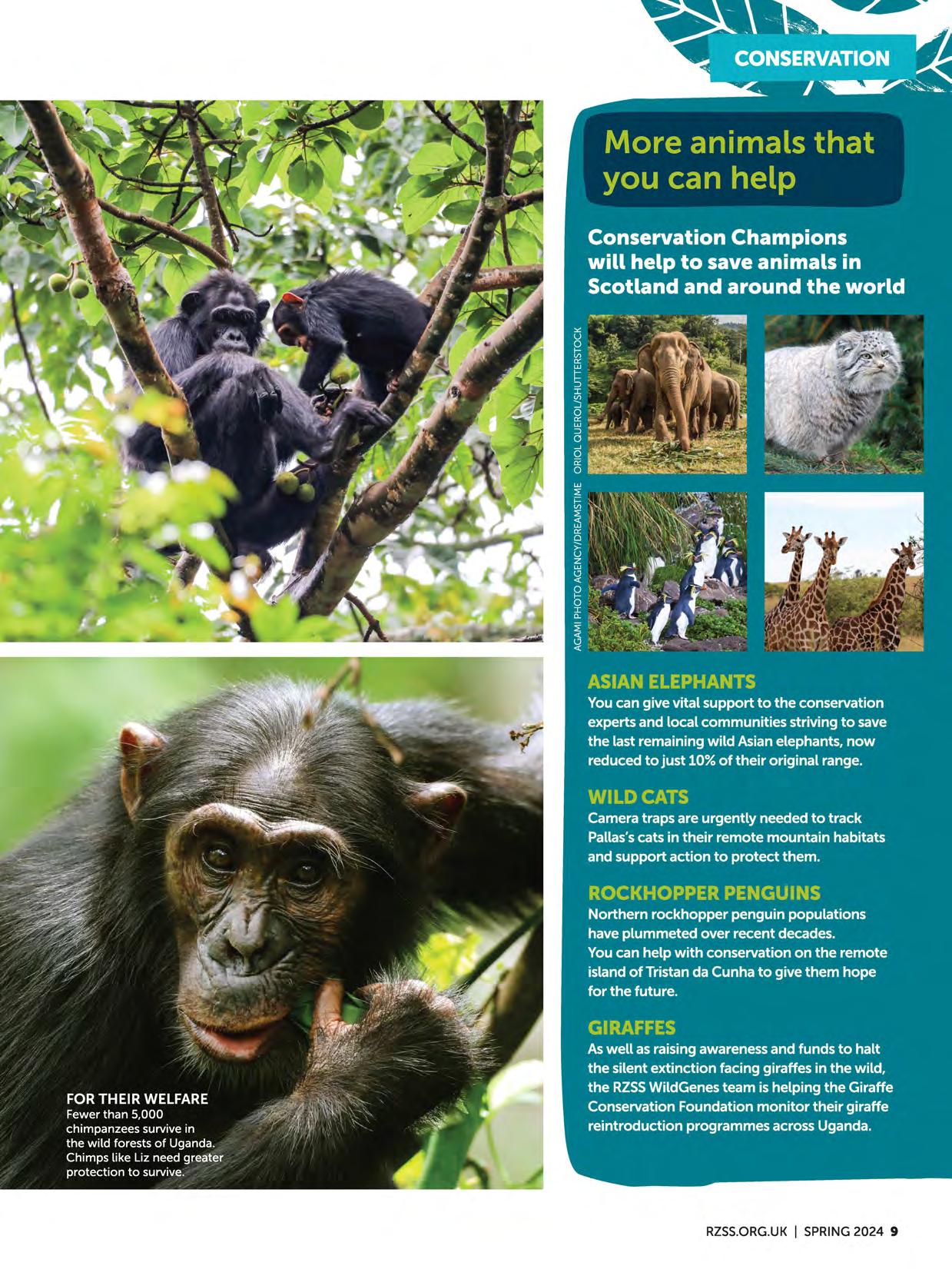
Species recovery projects need longterm support. By committing to work with BCFSfor the long haul we provide security, including funding more than 30 rangers working out in the rainforest. That way, we're able to help keep the population of chimps stable, fending off multiple threats on their behalf. "It'san enormous privilege to be working with the BCFSteam," says Helen. 'The work we're doing and what we're achieving there -with the support of RZSS's members and donors -is immense."
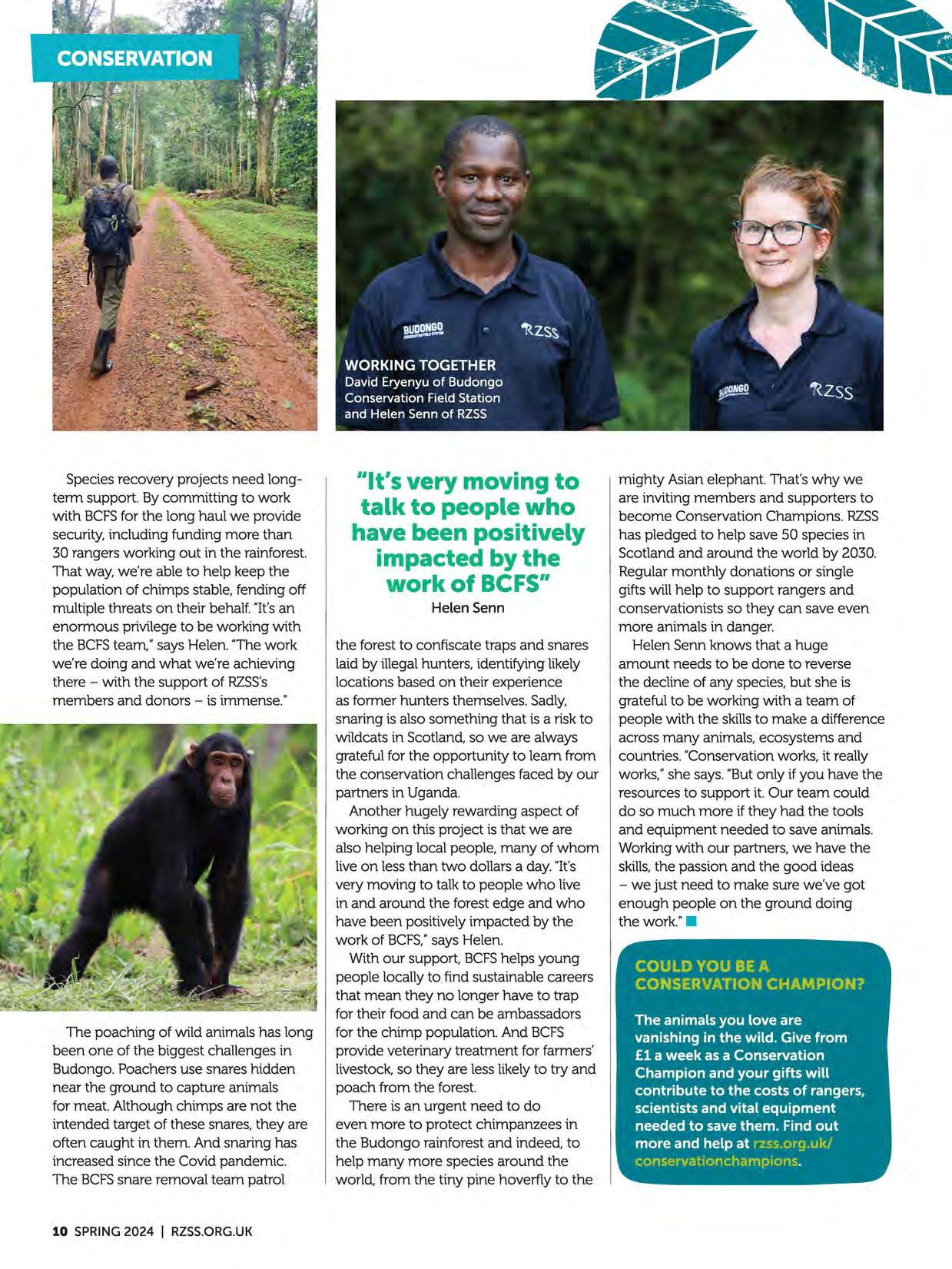
The poaching of wild animals has long been one of the biggest challenges in Budongo. Poachers use snares hidden near the ground to capture animals for meat. Although chimps are not the intended target of these snares, they are often caught in them. And snaring has increased since the Covid pandemic. The BCFSsnare removal team patrol
..It's very moving to talk to people who have been positively impacted by the work of BCFS"Helen Senn
the forest to confiscate traps and snares laid by illegal hunters, identifying likely locations based on their experience as former hunters themselves. Sadly, snaring is also something that is a risk to wildcats in Scotland, so we are always grateful for the opportunity to learn from the conservation challenges faced by our partners in Uganda.
Another hugely rewarding aspect of working on this project is that we are also helping local people, many of whom live on less than two dollars a day. "It's very moving to talk to people who live in and around the forest edge and who have been positively impacted by the work of BCFS,"says Helen.
With our support, BCFShelps young people locally to find sustainable careers that mean they no longer have to trap for their food and can be ambassadors for the chimp population. And BCFS provide veterinary treatment for farmers' livestock, so they are less likely to try and poach from the forest.
There is an urgent need to do even more to protect chimpanzees in the Budongo rainforest and indeed, to help many more species around the world, from the tiny pine hoverfly to the
mighty Asian elephant. That's why we are inviting members and supporters to become Conservation Champions. RZSS has pledged to help save 50 species in Scotland and around the world by 2030. Regular monthly donations or single gifts will help to support rangers and conservationists so they can save even more animals in danger.
Helen Senn knows that a huge amount needs to be done to reverse the decline of any species, but she is grateful to be working with a team of people with the skillsto make a difference across many animals, ecosystems and countries. "Conservation works, it really works," she says. "But only if you have the resources to support it. Our team could do so much more if they had the tools and equipment needed to save animals. Working with our partners, we have the skills,the passion and the good ideas -we just need to make sure we've got enough people on the ground doing the
The animals you love are vanishing in the wild. Give from £1 a week as a Conservation Champion and your gifts will contribute to the costs of rangers, scientists and vital equipment needed to save them. Find out more and help at rzss.org.uk/ conservationchampions.
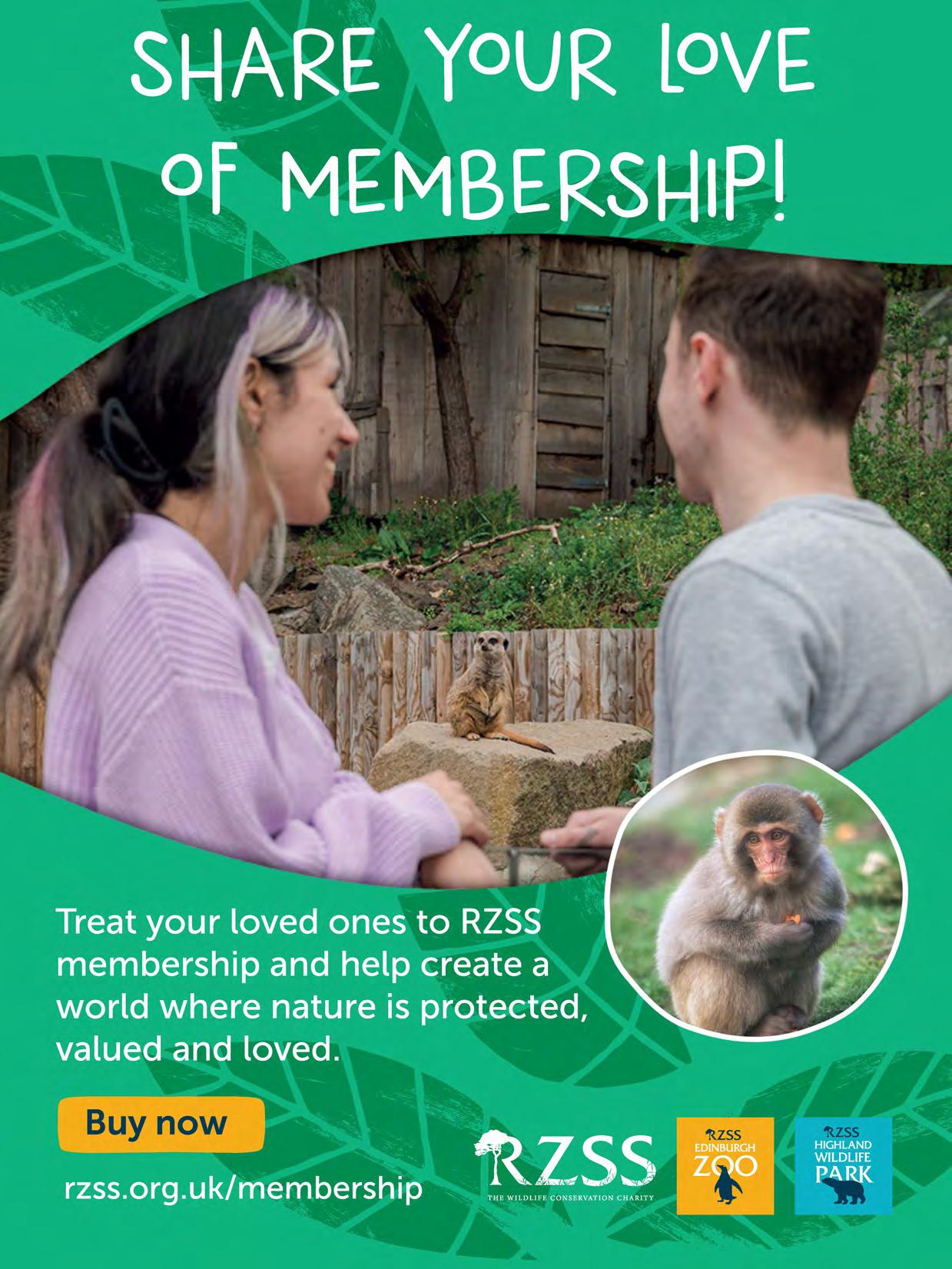
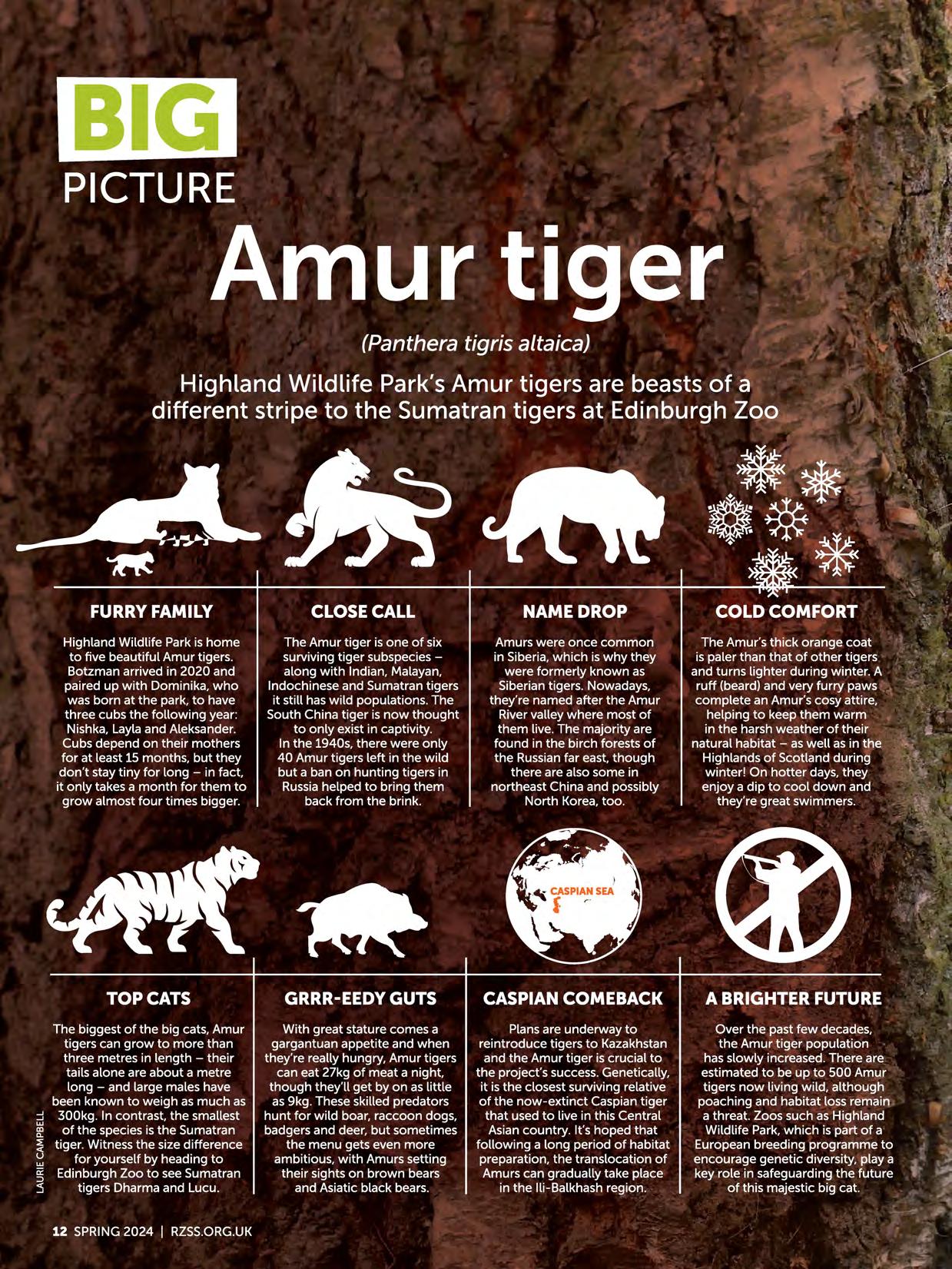
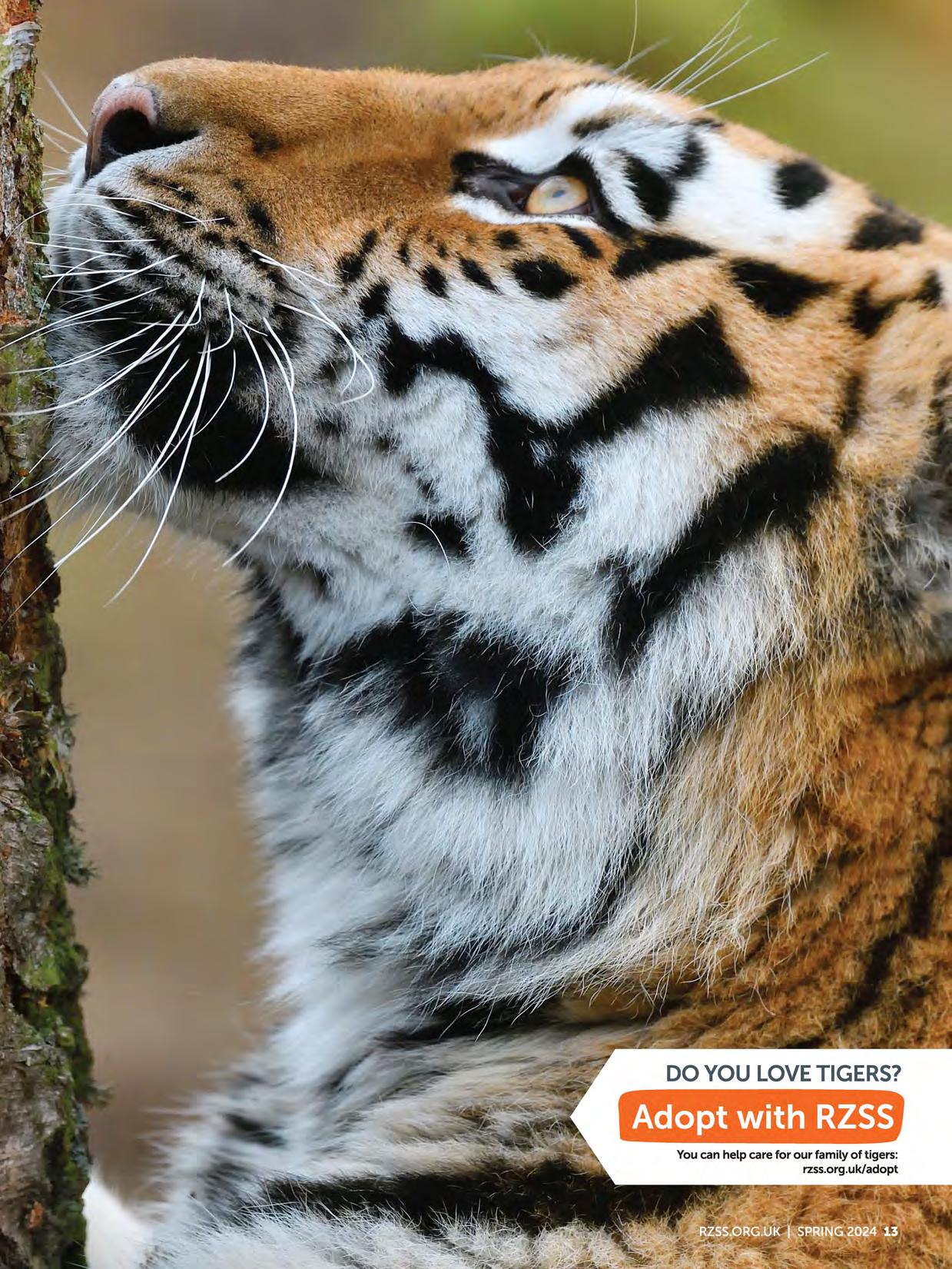
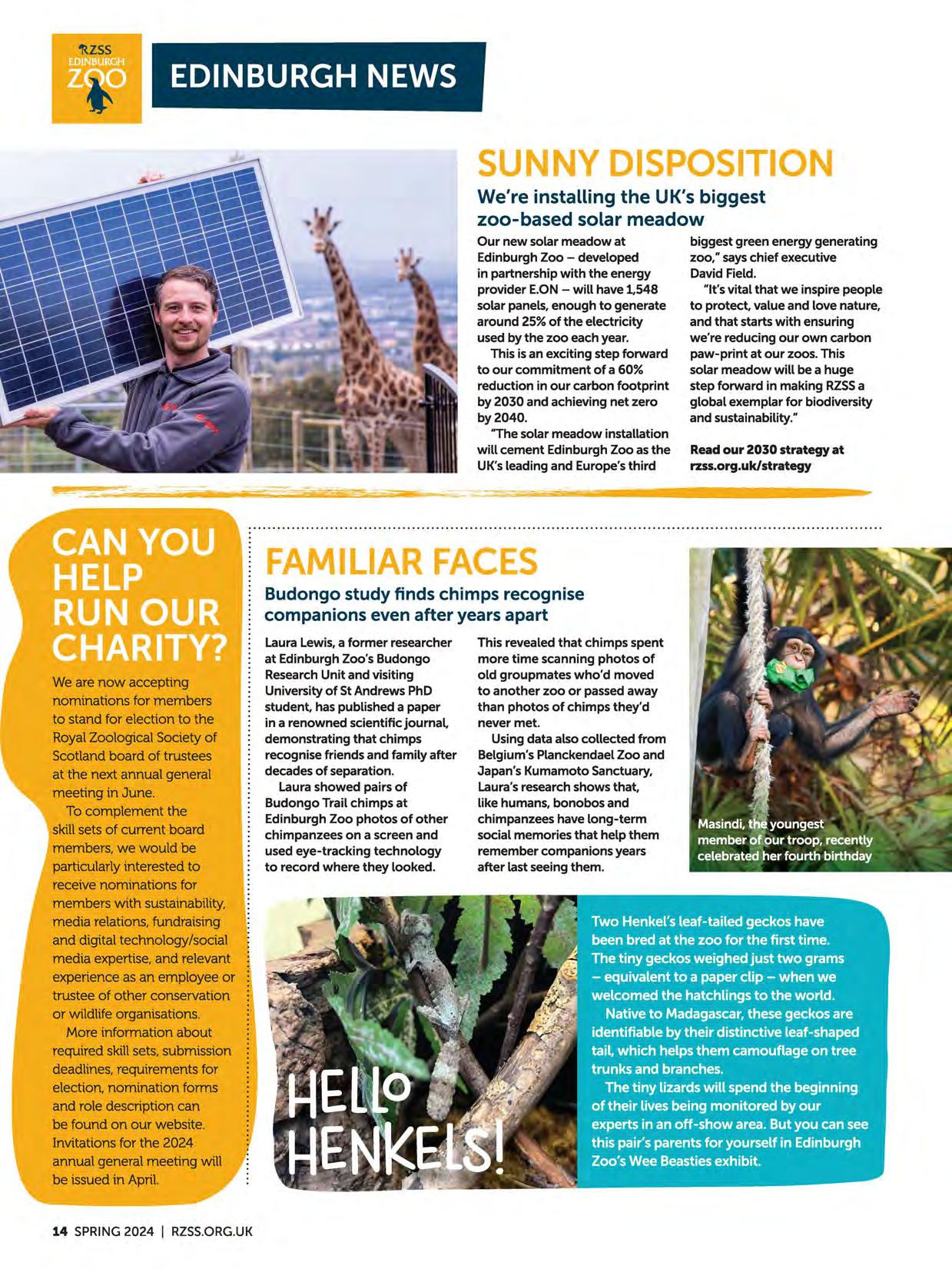
We are now accepting nominations for members to stand for election to the Royal Zoological Society of Scotland board of trustees at the next annual general meeting in June.
To complement the skill sets of current board members, we would be particularly interested to receive nominations for members with sustainability, media relations, fundraising and digital technology/social media expertise, and relevant experience as an employee or trustee of other conservation or wildlife organisations.
More information about required skill sets, submission deadlines, requirements for election, nomination forms and role description can be found on our website. Invitations for the 2024 annual general meeting will be issued in April.
Our new solar meadow at Edinburgh Zoo -developed in partnership with the energy provider E.ON -will have 1,548 solar panels, enough to generate around 25% of the electricity used by the zoo each year.
This is an exciting step forward to our commitment of a 60% reduction in our carbon footprint by 2030 and achieving net zero by 2040.
"The solar meadow installation will cement Edinburgh Zoo as the UK's leading and Europe's third
Budongo study finds chimps recognise companions even after years apart
Laura Lewis, a former researcher at Edinburgh Zoo's Budongo Research Unit and visiting University of St Andrews PhD student, has published a paper in a renowned scientific journal, demonstrating that chimps recognise friends and family after decades of separation.
Laura showed pairs of Budongo Trail chimps at Edinburgh Zoo photos of other chimpanzees on a screen and used eye-tracking technology to record where they looked.
This revealed that chimps spent more time scanning photos of old groupmates who'd moved to another zoo or passed away than photos of chimps they'd never met.
Using data also collected from Belgium's Planckendael Zoo and Japan's Kumamoto Sanctuary, Laura's research shows that, like humans, bonobos and chimpanzees have long-term social memories that help them remember companions years after last seeing them.
biggest green energy generating zoo," says chief executive David Field.
"It's vital that we inspire people to protect, value and love nature, and that starts with ensuring we're reducing our own carbon paw-print at our zoos. This solar meadow will be a huge step forward in making RZSSa global exemplar for biodiversity and sustainability."
Read our 2030 strategy at rzss.org.uk/strategy

The building of Scotland's Wildlife Discovery Centre -which will connect visitors more closely to wildlife and inspire them to protect nature -is coming along nicely ahead of its opening later this year.
The centre will have three new buildings: the Learning Hub, Discovery Hub and Conservation Hub.
The buildings will utilise lambswool for insulation to reduce plastic use and overall energy use, rely on air source heat pumps to take heat from the
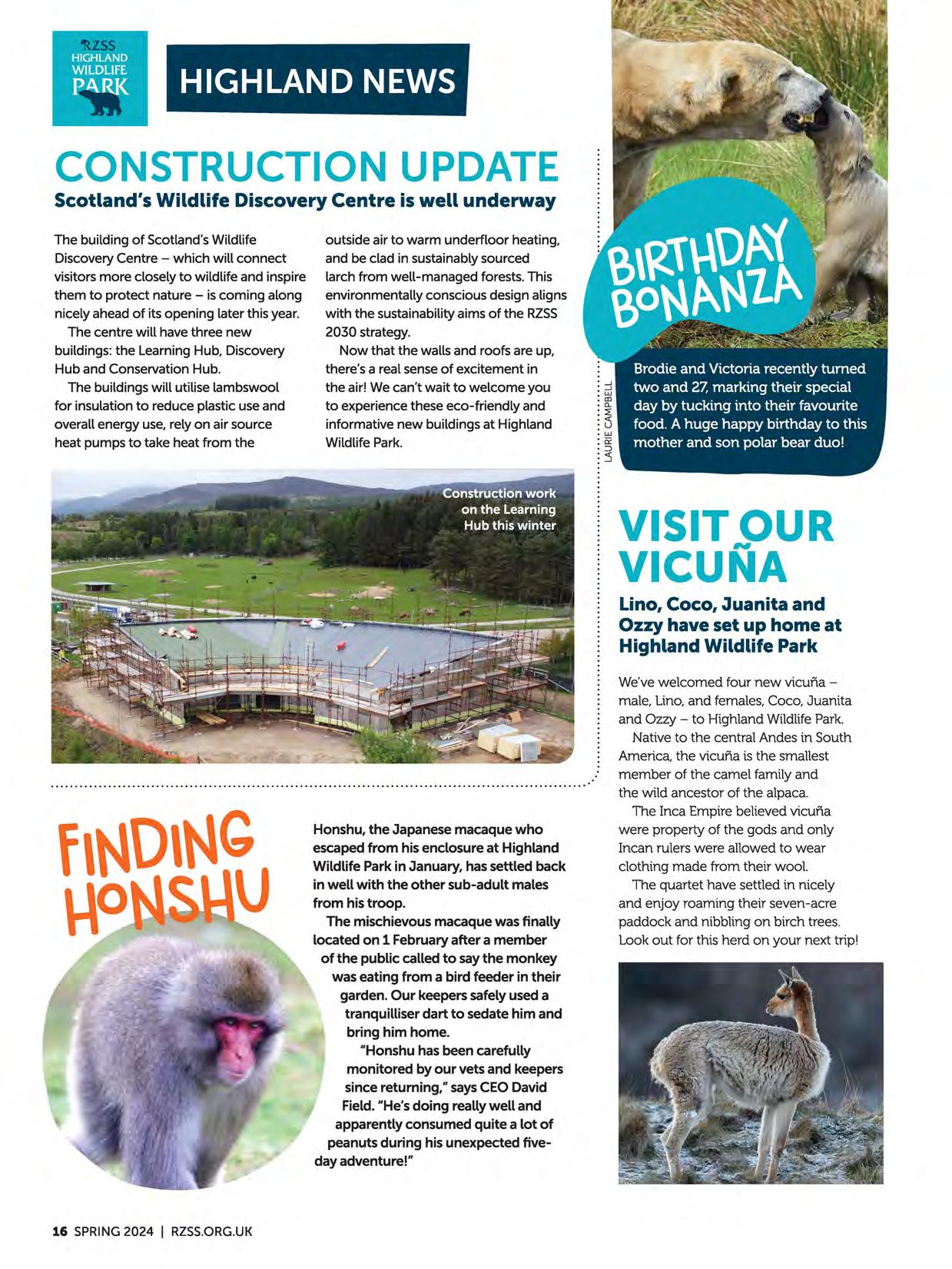
outside air to warm underfloor heating, and be clad in sustainably sourced larch from well-managed forests. This environmentally conscious design aligns with the sustainability aims of the RZSS 2030 strategy.
Now that the walls and roofs are up, there's a real sense of excitement in the air! We can't wait to welcome you to experience these eco-friendly and informative new buildings at Highland Wildlife Park.
Honshu,the Japanesemacaquewho escapedfrom hisenclosureat Highland Wildlife Park in January,hassettled back in well with the other sub-adult males from histroop.
The mischievousmacaquewas finally located on 1 Februaryafter a member of the public called to saythe monkey was eating from a bird feeder in their garden. Our keeperssafelyuseda tranquilliserdart to sedate him and bring him home.
"Honshuhas been carefully monitored by our vets and keepers since returning,"saysCEO David Field."He'sdoing reallywell and apparentlyconsumedquite a lot of peanutsduring hisunexpectedfiveday adventure!"
We've welcomed four new vicuf\amale, Lino, and females, Coco, Juanita and Ozzy -to Highland Wildlife Park.
Native to the central Andes in South America, the vicuf\a is the smallest member of the camel family and the wild ancestor of the alpaca.
The Inca Empire believed vicuf\a were property of the gods and only Incan rulers were allowed to wear clothing made from their wool.
The quartet have settled in nicely and enjoy roaming their seven-acre paddock and nibbling on birch trees. Look out for this herd on your next trip!
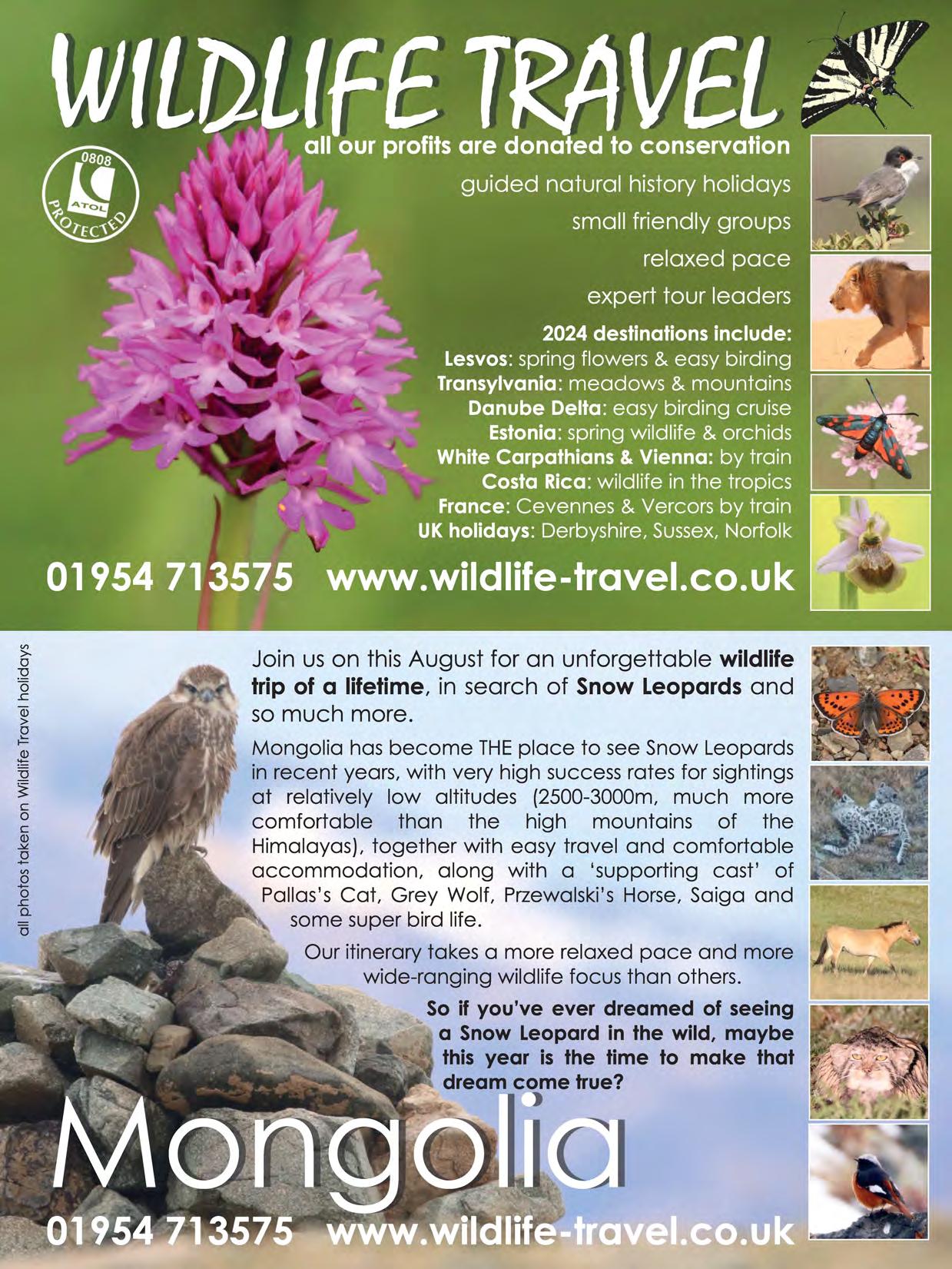
Join us on this August for an unforgettable wildlife trip of a lifetime, in search of Snow Leopards and so much more.
Mongolia has become THEplace to see Snow Leopards in recent years, with very high success rates for sightings at relatively low altitudes (2500-3000m, much more comfortable than the high mountains of the Himalayas), together with easy travel and comfortable accommodation, along with a 'supporting cast' of Pallas's Cat, Grey Wolf, Przewalski's Horse, Saiga and some super bird life.
Our itinerary takes a more relaxed pace and more wide-ranging wildlife focus than others.
So if you've ever dreamed of seeing a Snow Leopard in the wild, maybe this year is the time to make that dream come true?
FRENCH POLYNESIA
Hundreds of extremely rare Partula snails bred at the Royal Zoological Society of Scotland's Edinburgh Zoo have been flown 15,000km to be reintroduced to their French Polynesian home. Since 2015, conservationists have reintroduced more than 24,000 Partula snails onto French Polynesian islands, with each year's release painted with a dot of a different coloured glow-in-the-dark, animal-friendly 'snail varnish'so that their individual progress can be monitored with the help of a UV torchlight. The latest cohort have a blue spot.
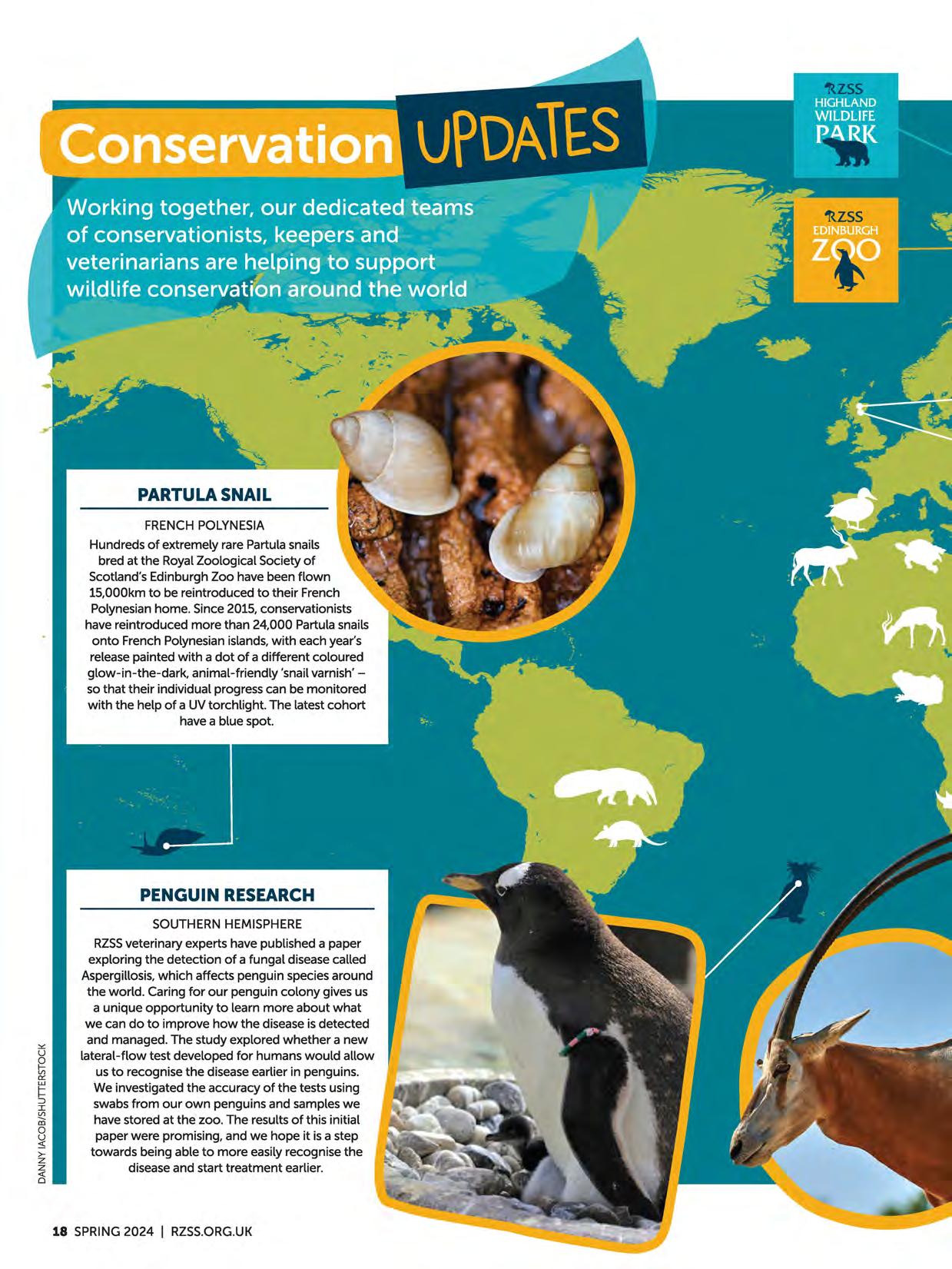
SOUTHERN HEMISPHERE
RZSSveterinary experts have published a paper exploring the detection of a fungal disease called Aspergillosis, which affects penguin species around the world. Caring for our penguin colony gives us a unique opportunity to learn more about what we can do to improve how the disease is detected and managed. The study explored whether a new lateral-flow test developed for humans would allow us to recognise the disease earlier in penguins. We investigated the accuracy of the tests using swabs from our own penguins and samples we have stored at the zoo. The results of this initial paper were promising, and we hope it is a step towards being able to more easily recognise the disease and start treatment earlier.
Recent studies published in the journal Current Biology by RZSSand academics at the Universities of Oxford and Bristol show that domestic cats introduced from the Near East and wildcats native to Europe did not mix until the 1960s, despite being exposed to each other for 2,000 years. The team genetically sequenced and analysed both wild and domestic cats, including 48 modern individuals and 258 ancient samples excavated from 85 archaeological sites over the last 8,500 years. The results of the studies demonstrate that domestic cats and European wildcats generally avoided mating until that changed in Scotland around 50 years ago.
One theory is that this may have been a result of reduced wildcat populations limiting the opportunity for them to mate within their own species.
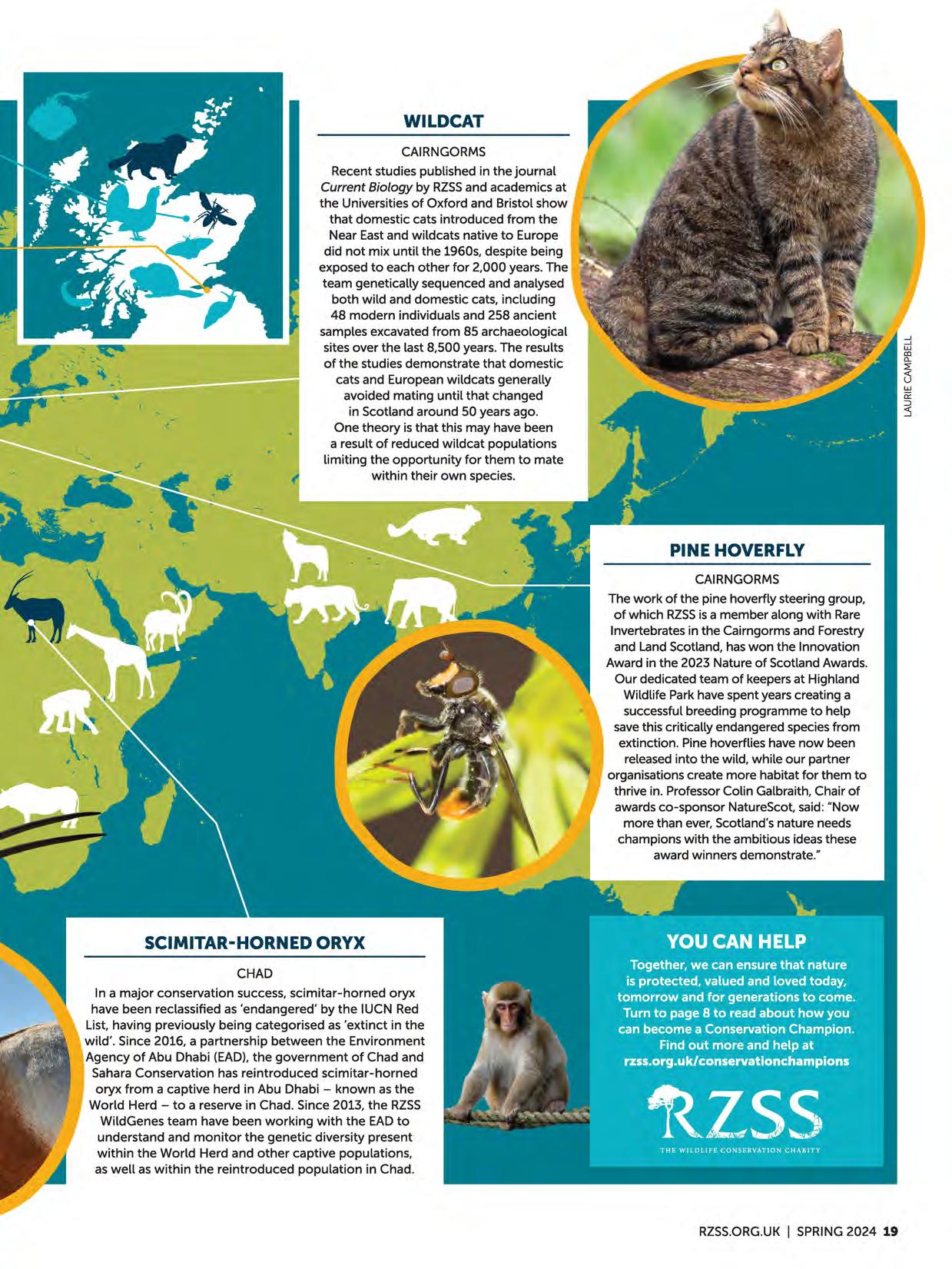
The work of the pine hoverfly steering group, of which RZSSis a member along with Rare Invertebrates in the Cairngorms and Forestry and Land Scotland, has won the Innovation Award in the 2023 Nature of Scotland Awards. Our dedicated team of keepers at Highland Wildlife Park have spent years creating a successful breeding programme to help save this critically endangered species from extinction. Pine hoverflies have now been released into the wild, while our partner organisations create more habitat for them to thrive in. Professor Colin Galbraith, Chair of awards co-sponsor NatureScot, said: "Now more than ever, Scotland's nature needs champions with the ambitious ideas these award winners demonstrate."
In a major conservation success, scimitar-horned oryx have been reclassified as 'endangered' by the IUCN Red List, having previously being categorised as 'extinct in the wild'. Since 2016, a partnership between the Environment Agency of Abu Dhabi (EADJ,the government of Chad and Sahara Conservation has reintroduced scimitar-horned oryx from a captive herd in Abu Dhabi -known as the World Herd -to a reserve in Chad. Since 2013, the RZSS WildGenes team have been working with the EAD to understand and monitor the genetic diversity present within the World Herd and other captive populations, as well as within the reintroduced population in Chad.
At Highland Wildlife Park, our adult male polar bears live in a separate enclosure to Victoria and her two-year-old son, Brodie. Brodie's father, Arktos, lives contentedly alongside our other adult male, Walker, who is Victoria's nephew.
'The males live together really well," says RZSScurator Jo Elliott. "If Victoria was a bit closer, they would perhaps get a bit more tense around breeding season, but they seem to tolerate each other well."
Eventually, Victoria will become less comfortable living alongside her son, and Brodie will need to find a new home, but as Jo explains, that's not easy. "It's a challenge to find a home for a polar bear. We give them a really good life, with enormous enclosures. It's lovely and cold and there's loads of water so they've got natural pools to dip into and stay cool, and we want them to go somewhere similar."
If you've been visiting Highland Wildlife Park for a few years, you might also remember Victoria and Arktos's son Hamish, the first polar bear cub born in the UK for 25 years. He now lives in Doncaster at Yorkshire Wildlife Park.
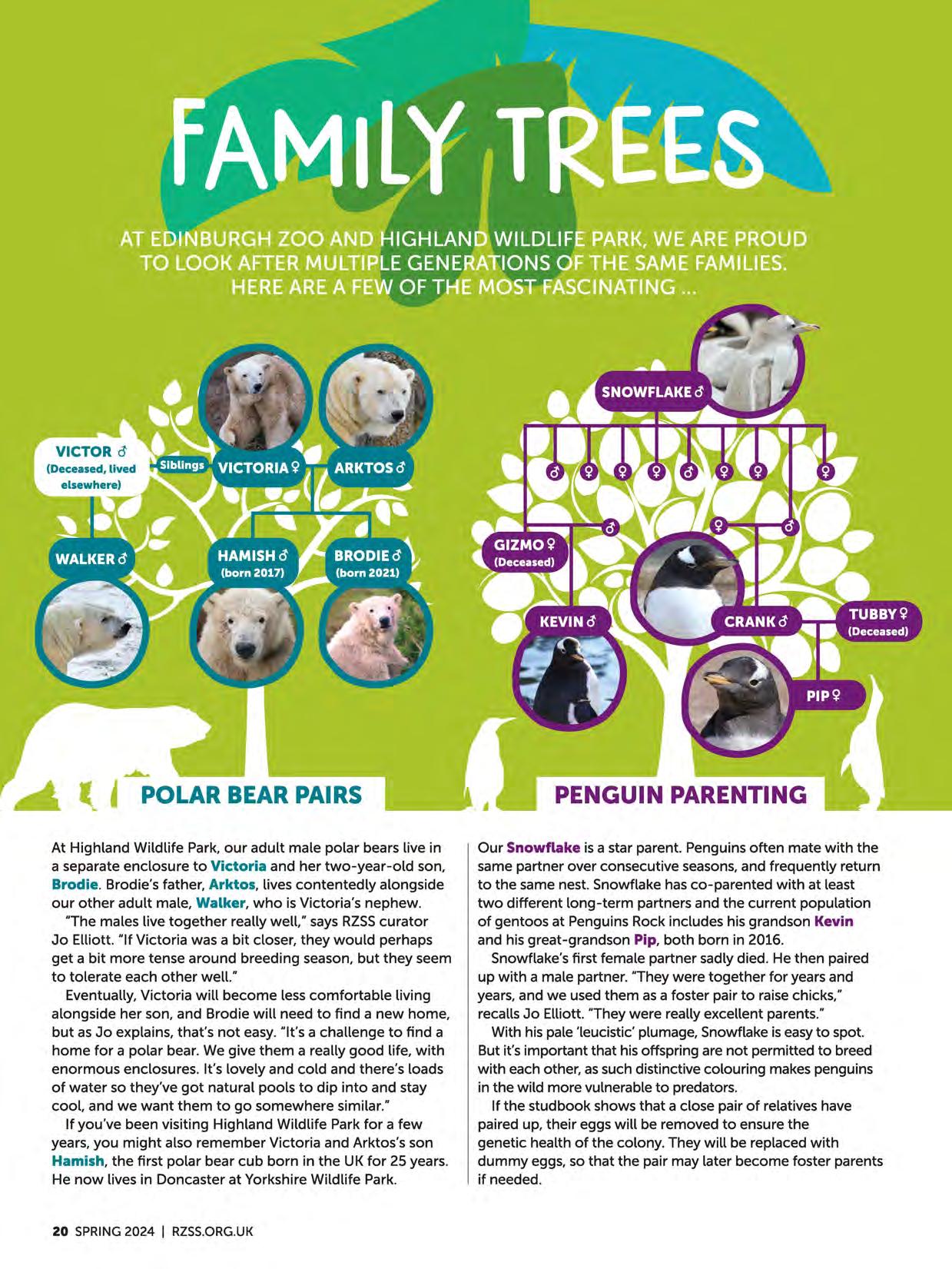
Our Snowflake is a star parent. Penguins often mate with the same partner over consecutive seasons, and frequently return to the same nest. Snowflake has co-parented with at least two different long-term partners and the current population of gentoos at Penguins Rock includes his grandson Kevin and his great-grandson Pip, both born in 2016.
Snowflake's first female partner sadly died. He then paired up with a male partner. 'They were together for years and years, and we used them as a foster pair to raise chicks," recalls Jo Elliott. "They were really excellent parents."
With his pale 'leucistic' plumage, Snowflake is easy to spot. But it's important that his offspring are not permitted to breed with each other, as such distinctive colouring makes penguins in the wild more vulnerable to predators.
If the studbook shows that a close pair of relatives have paired up, their eggs will be removed to ensure the genetic health of the colony. They will be replaced with dummy eggs, so that the pair may later become foster parents if needed.
The young male giraffes at Edinburgh Zoo are all descended from two pairs that previously lived here. They were deliberately brought together when they were young so they could bond as a group. Although they currently live without any females, this 'bachelor herd' of Gilbert, Ronnie, Arrow, Fennessy and Gerald is nevertheless part of a European breeding programme. "We only want to breed from specific genetic lines -so we have the right number of giraffes for the right number of zoos at any given time, and so that the right genetics go through to the next generation," says Jo Elliott. "It means there are always going to be giraffes that aren't needed for breeding, and so zoos hold bachelor herds."
In future, some of these giraffes may be moved to other zoos to breed with a female partner.
"Social bonding is really important for giraffes," says Jo. "So, if we sent one to pair up with a female somewhere else, he would go there to stay."

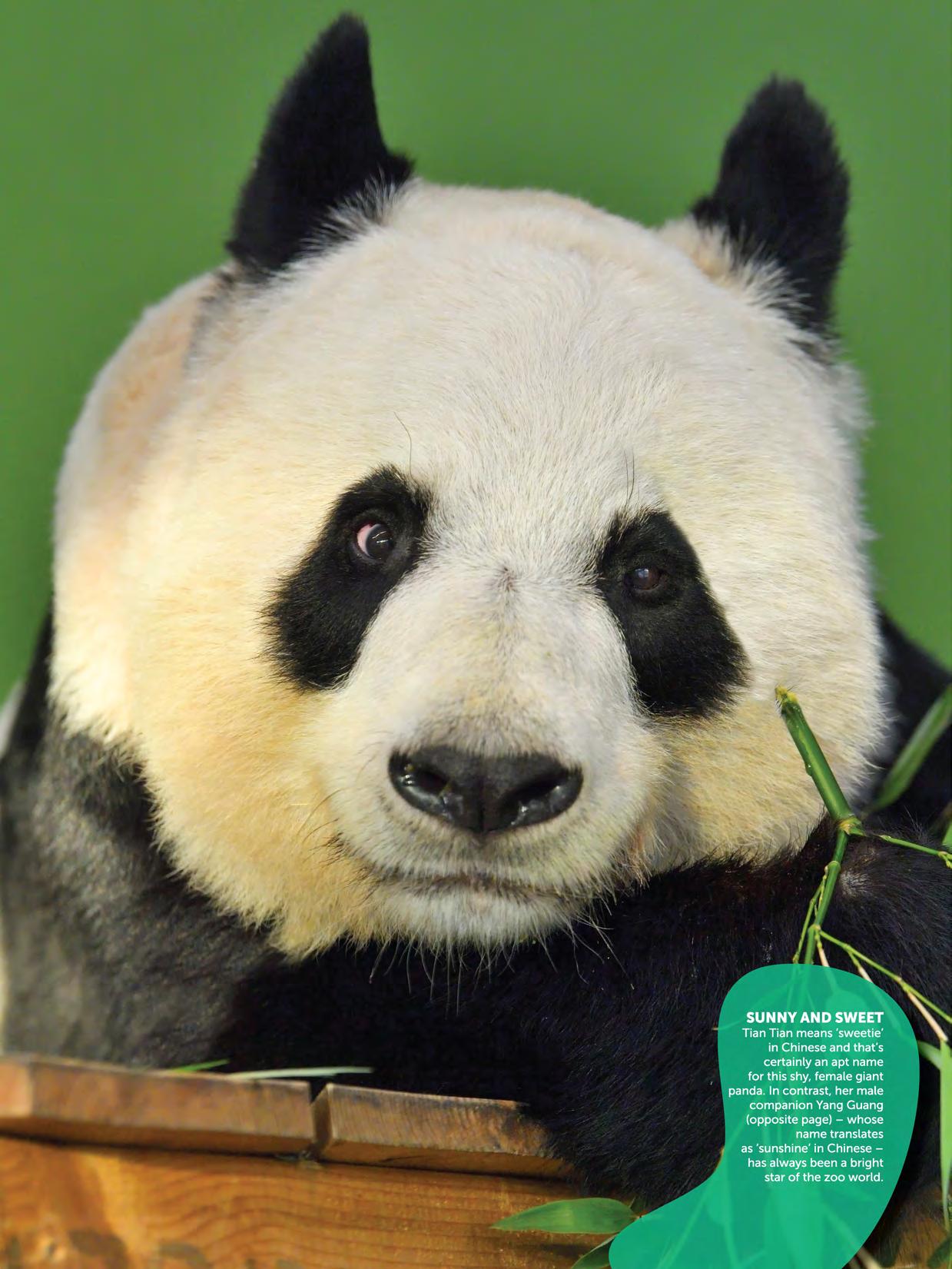
At the end of last year, Edinburgh Zoo said goodbye to Yang Guang and Tian Tian. Journalist Jonathan McIntosh spoke to their keepers to learn more about the pandas' return to China
Ever since joining us at Edinburgh Zoo in December 2011, Tian Tian and Yang Guang have been among the most popular animals cared for by the Royal Zoological Society of Scotland. The beloved pair of giant pandas initially came to Scotland as part of a 10-year agreement between RZSS and the China Wildlife Conservation Association, but that was later extended to 12 years due to the complications of the COVIDpandemic.
Everyone at the zoo loved having the company of Tian Tian and Yang Guang for those two extra years, but all good things must come to an end -as proved true when the 20-year-old pandas left Scotland on 4 December 2023 to return to China's Szechuan province. Not long after their departure, I took the opportunity to speak to those who knew the pandas best to find out some of the highlights of their time in Edinburgh, as well as how they were prepared for their journey to China, the emotional final goodbyes and the next chapter in the animals' lives.
Edinburgh Zoo's head of living j collections Darren McGarry and carnivore team leader and chief i5panda keeper Alison Maclean first met Yang Guang and Tian Tian at China's Bifengxia Giant Panda base in 2010.

Yang Guang was identified as the more laid-back of the pair while Tian Tian was a little shyer.
"Edinburgh Zoo's acquisition of Tian Tian and Yang Guang was very important because they were the UK's first giant pandas since London Zoo's Ming Ming left in 1994,"recalls Darren.
"We put together a panda care plan based on how we look after our south-east Asian sun bears. But when Tian Tian and Yang Guang arrived, we realised we had to adapt. It was a steep learning curveespecially as pandas are very sensitive to changes in their environmentbut we hit the ground running to provide them with the best care."
Greater understanding
The pandas' respective personalities turned out to be very much as anticipated: Yang Guang was confident and comfortable with visitors, while Tian Tian was more timid and happier in her own company, although she learned to trust the staff she got to know at the zoo.
Over the past 12 years, Edinburgh Zoo's team have also been collecting daily statistics on Tian Tian and Yang Guang. This has contributed to significant strides forward in panda research and veterinary care, which RZSShope will help giant pandas around the world in the future.
Simon Girling,the RZSS'shead of veterinary services, published a now widely used pioneering panda anaesthetic protocol that has a quicker effect and recovery. And a collaborative project with Edinburgh's Royal Botanic Garden has provided clearer insight as to what these animals eat in the wild. Sadly, the pair did not have any young, but RZSSalso worked with Dr Kirsten Wilson from the Medical Research Council Centre for Reproductive Health at the University of Edinburgh on a new hormone analysis technique that accurately identifies panda ovulation.
Yang Guang and Tian Tian have also been incredible ambassadors for
their species and animals everywhere. Through public-facing programmes like Beyond the Panda, Edinburgh Zoo's experts have educated visitors about giant pandas and about how RZSSis working to safeguard wildlife worldwide through our conservation programmes.
Preparing for the journey ahead
About a year before Tian Tian and Yang Guang returned to China's Chengdu Research Base of Giant Panda Breeding, Darren and the rest of Edinburgh Zoo's panda team started paperwork and logistics. The panda keepers also began preparing Tian Tian and Yang Guang for the journey home.
One of the members of this team was senior keeper Michael Livingstone. Working in Edinburgh Zoo's carnivore section for the past 14 years, Michael helped care for the duo right from their earliest days at the zoo.
"I was just a young zookeeper when Tian Tian and Yang Guang got here, so I've grown up with them in a way," he says. "I've got fond memories of how amazed everyone was when we first opened the panda experience to visitors. Everybody was amazed at seeing a panda in real life!"
During their time at Edinburgh Zoo, Tian Tian and Yang Guang kept their

keepers very busy. "In the best way possible, looking after the pandas took up a lot of brain space - even when you weren't working with them," says Michael. "Whether performing health checks, preparing them for breeding season, or providing their everyday care, it was a lot of fun managing their busy panda calendar."
Tian Tian and Yang Guang's final year at Edinburgh Zoo was just as packed -especially as the team had to start preparing them for the flight to China, on which Michael also travelled.
To transport the pandas comfortably, Edinburgh Zoo's blacksmith, Rab Clark,
constructed two bespoke metal crates with sliding padlock doors, pee trays and removable screens so Michael could check on Tian Tian and Yang Guang during the flight.
"We'd already trained them to sit in similar crates for weigh-ins and health checks, so they got used to these transport crates very quickly,"explains Michael. Measuring 1.8m by 1.5m by 1.2m, the crates gave Tian Tian and Yang Guang plenty of room to snooze and tuck into bamboo.
As well as settling them into their new VIP (Very Important Panda) transport boxes, Michael and the team spent the final few weeks with Tian Tian and Yang Guang training them to wake up early. Both are fond of a lie-in, but the team wanted to be confident that the pandas would wake fresh as daisies for their early morning flight.
And as Tian Tian and Yang Guang's departure edged closer, emotions at Edinburgh Zoo ran higher. "Everyone was sad to see Tian Tian and Yang Guang go," says Michael. "From the visitors flocking to the zoo for one last goodbye, to staff who'd gotten to know them, so many people had special connections with these animals."
In the weeks ahead of travelling, the zoo's vets continually checked that the pandas were fit to travel. On 30 November, Yang Guang and Tian Tian's enclosure was closed off from visitors in anticipation of the big journey ahead.
Thanks to the team's meticulous prepping, planning and training, everything ran like clockwork on the day. Many staff came along to see the pandas off as they were transported from the zoo to Edinburgh Airport via a low-loader transport lorry. They were then put on a specially chartered China Southern plane headed to Chengdu.
"The morning couldn't have gone ci a, better," explains Michael. "But then the o.. j reality that Tian Tian and Yang Guang u.J had gone hit hard. I think because we'd "' been so busy preparing, we didn't have time to really think about their leaving. It was really quite sad!"

Michael and the pandas were joined by vet Stephanie Mota as well as a panda keeper from Wolong Panda Centre, Mr Lee. The only other person on the plane apart from the pilot and co-pilot was an official from the airline. During the 13-hour flight, Stephanie carried out health checks on the two pandas, while Michael ensured they were happily fed and watered.
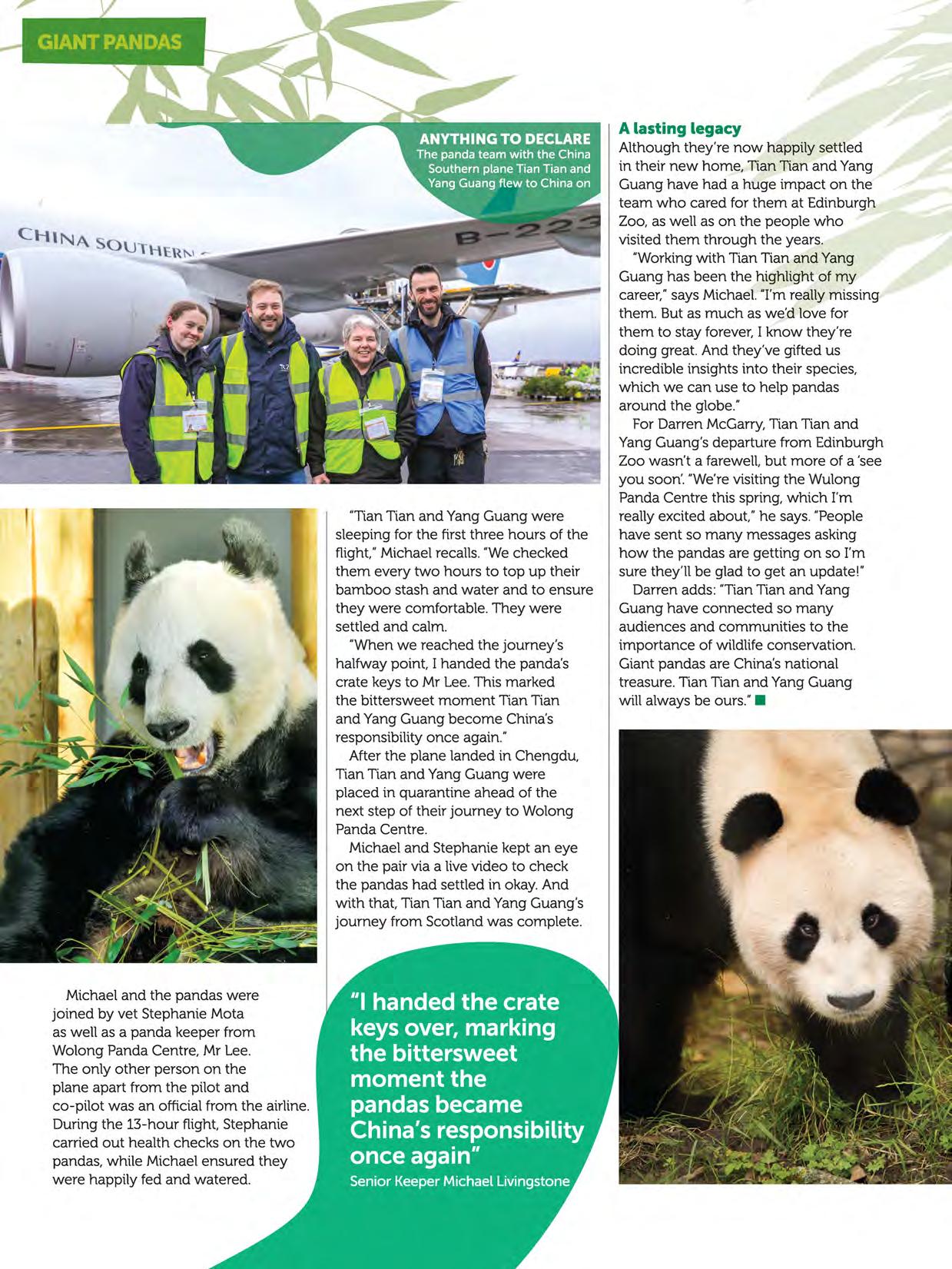
"Tian Tian and Yang Guang were sleeping for the first three hours of the flight," Michael recalls. "We checked them every two hours to top up their bamboo stash and water and to ensure they were comfortable. They were settled and calm.
"When we reached the journey's halfway point, I handed the panda's crate keys to Mr Lee. This marked the bittersweet moment Tian Tian and Yang Guang become China's responsibility once again."
After the plane landed in Chengdu, Tian Tian and Yang Guang were placed in quarantine ahead of the next step of their journey to Wolong Panda Centre.
Michael and Stephanie kept an eye on the pair via a live video to check the pandas had settled in okay. And with that, Tian Tian and Yang Guang's journey from Scotland was complete.
Although they're now happily settled in their new home, Tian Tian and Yang Guang have had a huge impact on the team who cared for them at Edinburgh Zoo, as well as on the people who visited them through the years.
"Working with Tian Tian and Yang Guang has been the highlight of my career," says Michael. Tm really missing them. But as much as we'd love for them to stay forever, I know they're doing great. And they've gifted us incredible insights into their species, which we can use to help pandas around the globe."
For Darren McGarry, Tian Tian and Yang Guang's departure from Edinburgh Zoo wasn't a farewell, but more of a 'see you soon'. "We're visiting the Wulong Panda Centre this spring, which I'm really excited about," he says. "People have sent so many messages asking how the pandas are getting on so I'm sure they'll be glad to get an update!"
Darren adds: "Tian Tian and Yang Guang have connected so many audiences and communities to the importance of wildlife conservation. Giant pandas are China's national treasure. Tian Tian and Yang Guang will always be ours."
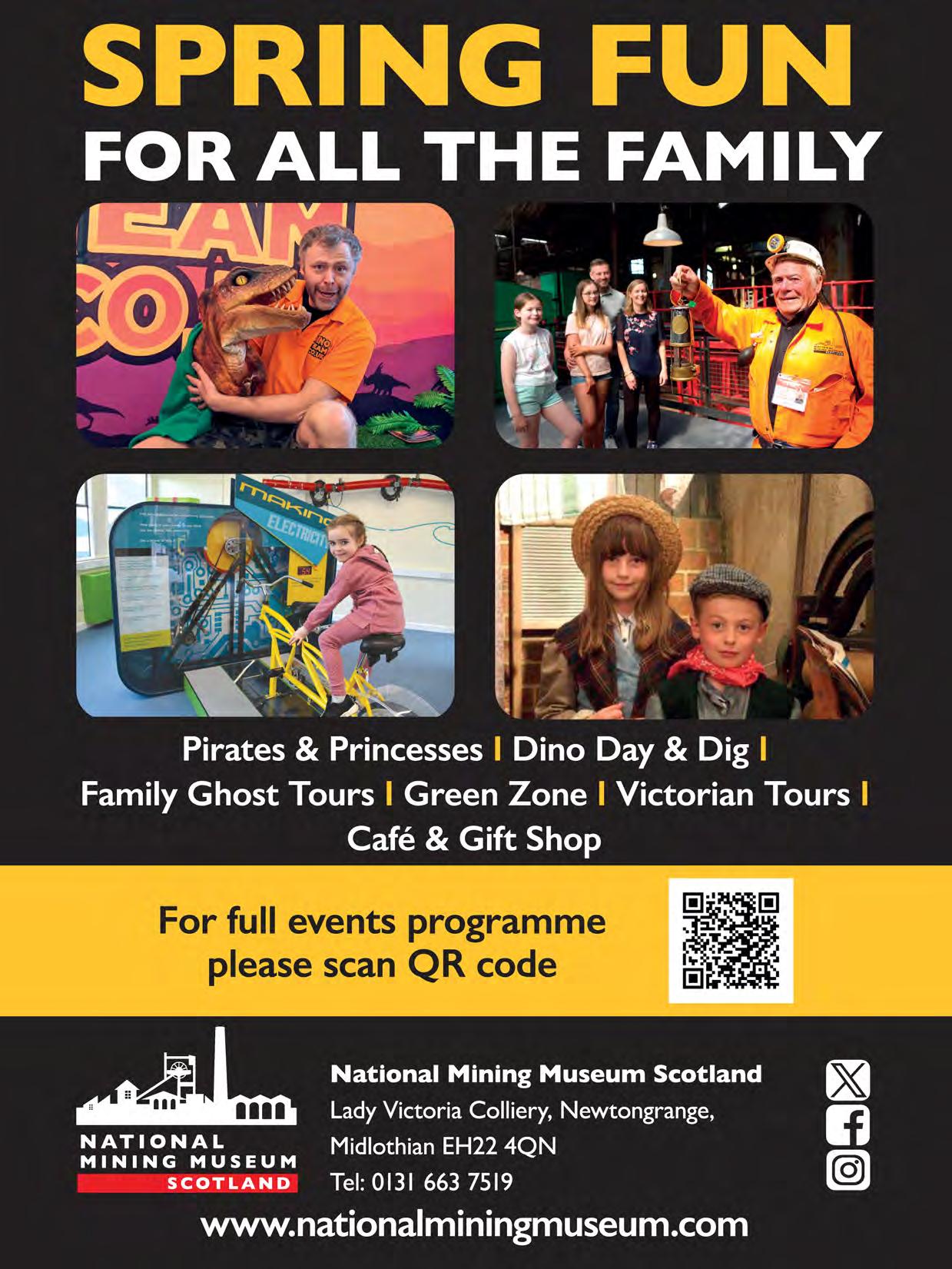
Nestled between the Sloths and Armadillos building and Living Links lies the Animal Antics arena, which has been part of Edinburgh Zoo's animal experiences section for over 20 years.
Jess Brown, team leader of the animal experiences team, has worked at Animal Antics since first joining the zoo as a summer keeper. Almost 12 years later, it remains one of her favourite parts of the job.
'The Animal Antics shows let our animals display their natural behaviours and adaptations that their species have developed in the wild. Visitors can also get up close to the animals -aligning with RZSS's
mission of connecting people more closely to nature," explains Jess.
"Yousee big smiles on people's faces as birds of prey fly overhead, when armadillos are wandering or if animals do something unexpected."
Among the 20 diverse creatures who call Animal Antics home are Mabli the turkey vulture {whose name means loveable in Welsh), the inseparable barn owls Rowan and Cedar and Kato the African ground hornbill.
"We spend so much time caring for these animals that you end up knowing their behaviours and intricacies inside out," explains Jess.
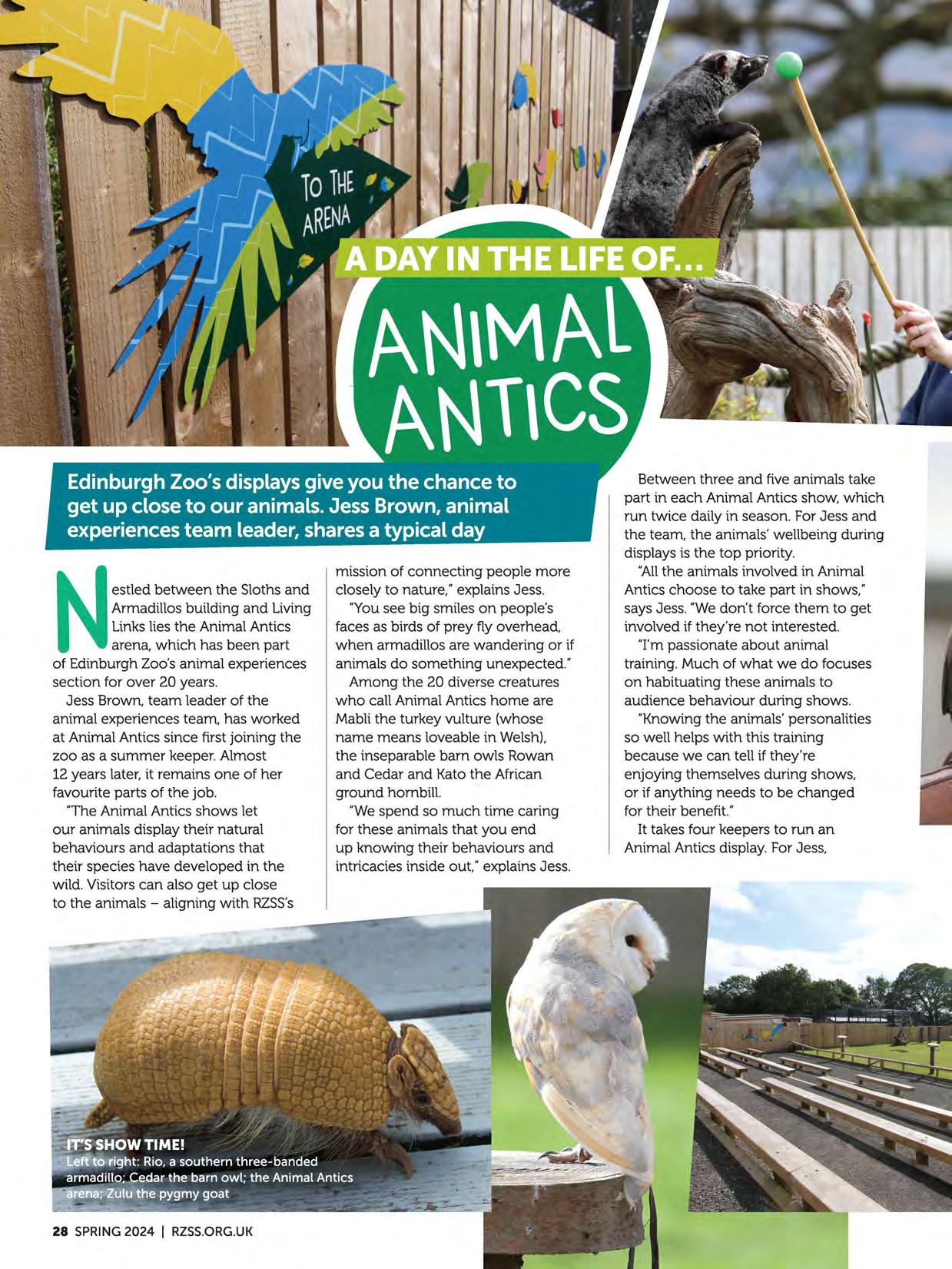
Between three and five animals take part in each Animal Antics show, which run twice daily in season. For Jess and the team, the animals' wellbeing during displays is the top priority.
"Allthe animals involved in Animal Antics choose to take part in shows," says Jess. "We don't force them to get involved if they're not interested.
Tm passionate about animal training. Much of what we do focuses on habituating these animals to audience behaviour during shows.
"Knowing the animals' personalities so well helps with this training because we can tell if they're enjoying themselves during shows, or if anything needs to be changed for their benefit."
It takes four keepers to run an Animal Antics display. For Jess,
LET US PREY
Nina the black kite
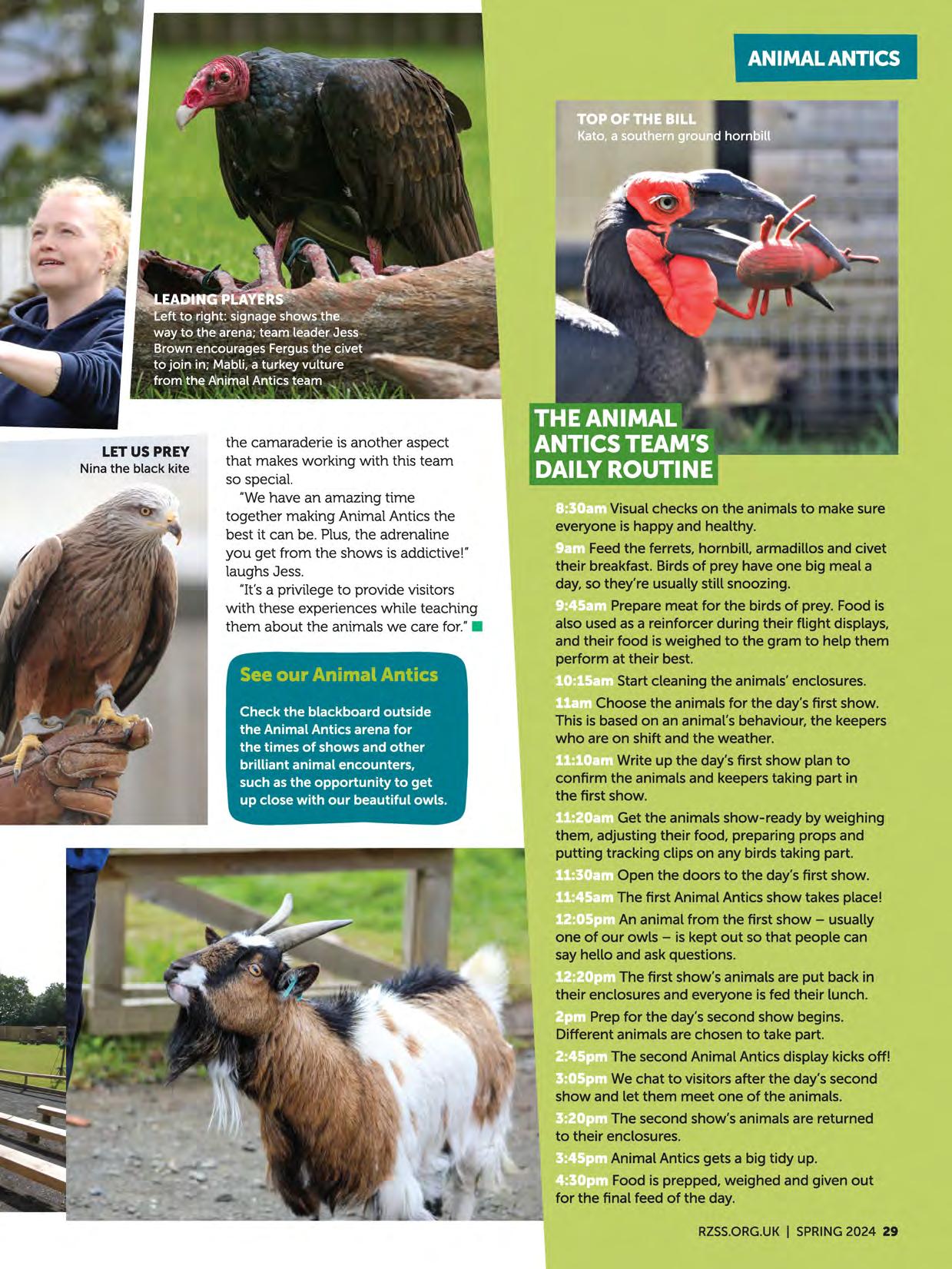
the camaraderie is another aspect that makes working with this team so special.
"We have an amazing time together making Animal Antics the best it can be. Plus, the adrenaline you get from the shows is addictive!" laughs Jess.
"It's a privilege to provide visitors with these experiences while teaching them about the animals we care for."
Check the blackboard outside the Animal Antics arena for the times of shows and other brilliant animal encounters, such as the opportunity to get up close with our beautiful owls.
"-'""""""'-'CJ.LLIVisualchecks on the animals to make sure everyone is happy and healthy.
Feed the ferrets, hornbill, armadillos and civet their breakfast. Birds of prey have one big meal a day, so they're usually still snoozing.
~4,,,1,;.u.u Prepare meat for the birds of prey. Food is also used as a reinforcer during their flight displays, and their food is weighed to the gram to help them perform at their best.
-~~= Start cleaning the animals' enclosures. Choose the animals for the day's first show. This is based on an animal's behaviour, the keepers who are on shift and the weather.
~l:C.l.:.1.a..1.wWrite up the day's first show plan to confirm the animals and keepers taking part in the first show.
,:.;i;..:i..::1...,i.u. Get the animals show-ready by weighing them, adjusting their food, preparing props and putting tracking clips on any birds taking part.
i;.;i;.;..;.i..:...1..1.LJ Open the doors to the day's first show .
._._..._..:..;J. The first Animal Antics show takes place!
__ .,___An animal from the first show -usually one of our owls -is kept out so that people can say hello and ask questions.
__ ,.___The first show's animals are put back in their enclosures and everyone is fed their lunch.
Prep for the day's second show begins. Different animals are chosen to take part.
The second Animal Antics display kicks off! We chat to visitors after the day's second show and let them meet one of the animals.
The second show's animals are returned to their enclosures.
Animal Antics gets a big tidy up.
___ .......,Food is prepped, weighed and given out for the final feed of the day.
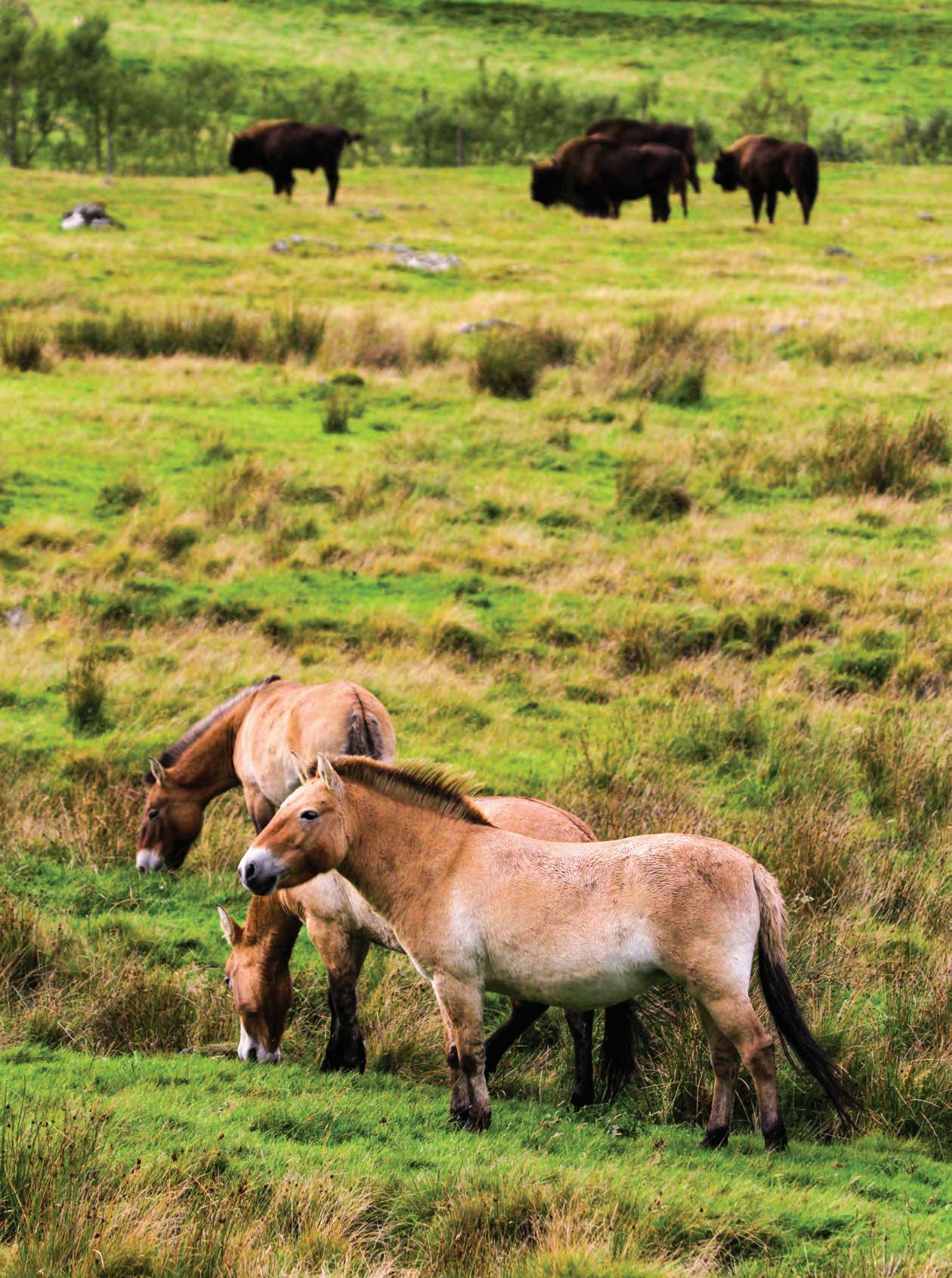
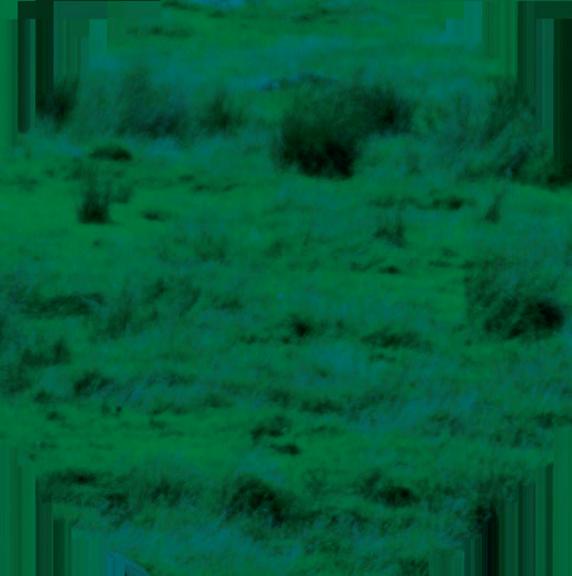
y excitement starts to build before I even arrive at Highland Wildlife Park to explore the drive-through reserve.
Senior hoofstock keeper Becky Pink has told me to bring my wellies, so that I can accompany the team as they feed and check the animals before the first visitors arrive for the day.
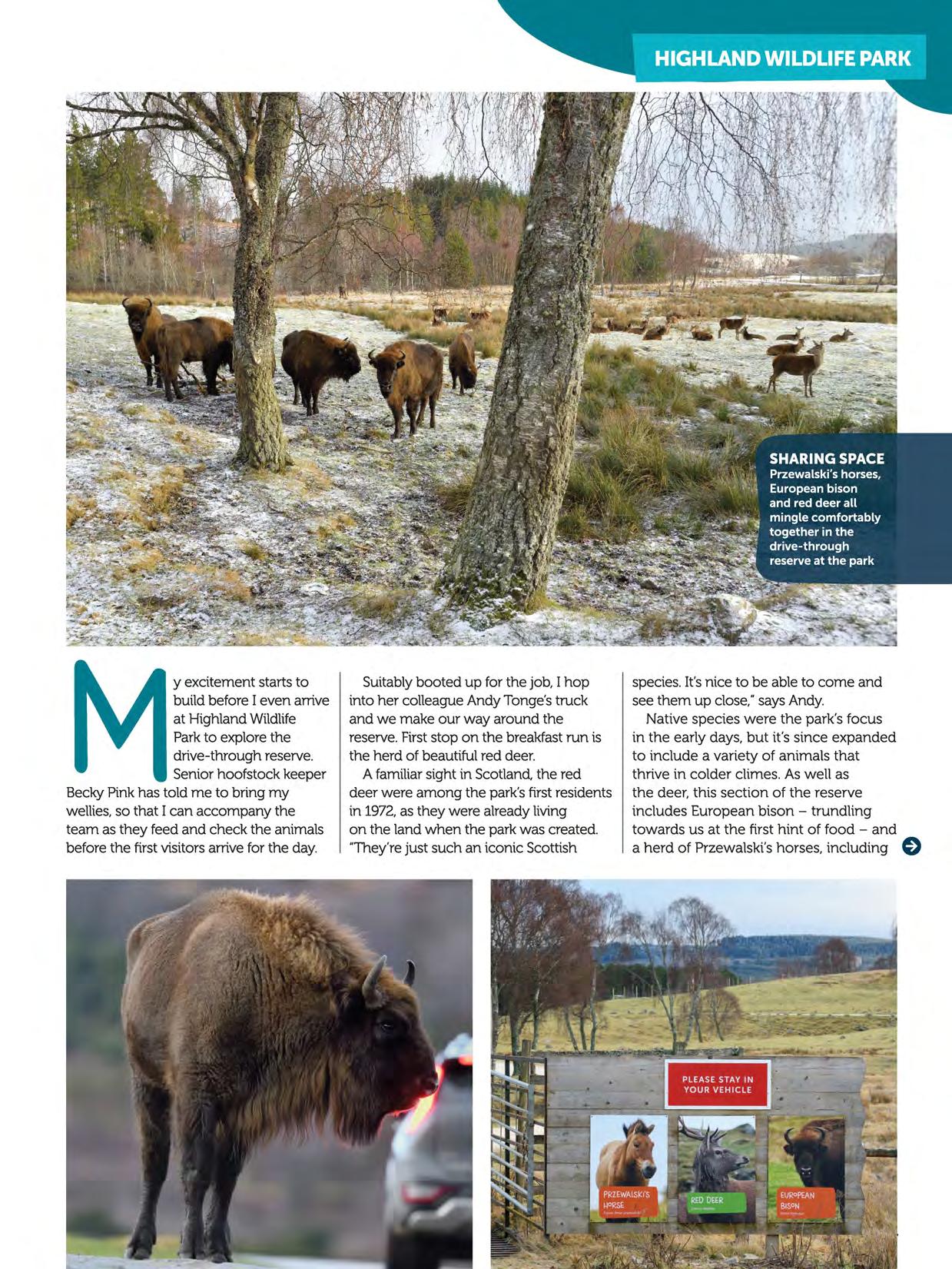
Suitably booted up for the job, I hop into her colleague Andy Tonge's truck and we make our way around the reserve. First stop on the breakfast run is the herd of beautiful red deer.
A familiar sight in Scotland, the red deer were among the park's first residents in 1972,as they were already living on the land when the park was created. "They're just such an iconic Scottish
species. It's nice to be able to come and see them up close," says Andy.
Native species were the park's focus in the early days, but it's since expanded to include a variety of animals that thrive in colder climes. As well as the deer, this section of the reserve includes European bison -trundling towards us at the first hint of food -and a herd of Przewalski's horses, including 0
Qoyor the stallion, whose arrival in 2022 means there are high hopes of foals this year.
In stark contrast to the ubiquitous red deer, these species vanished from their native habitats in Mongolia in the 20th century. 'They went extinct in the wild," says Andy, "and it's through zoo work and reintroduction projects that the numbers have come back up again."

We head towards the white-lipped deer enclosure to meet Becky,while Andy tells me about some of the wild animals that also make their homes in the reserve, from wading birds to mining bees.
"Spring is a really good time for waders," he says. "We have five species in particular that come here: lapwings, oystercatchers, snipe, redshank and curlews."
It's easy to catch sight of lapwings and oystercatchers, especially in May. "Snipe and redshank are much more secretive," he continues, "but you can often see the snipe doing their display flights, called drumming."
The white-lipped deer have inadvertently made their paddock a haven for these wading birds.
"They love wallowing in the water and running around in the mud," Andy explains. "It destroyed a lot of shrubs and thick reeds, and it actually made a muddy area that became really popular with young waders, where they can pick up worms and grubs."
This reserve is regarded as a significant site for local birds and surveys are carried out to keep track of numbers. Becky describes how everyone bands together to tally up the waders once a year, as well as doing an official RSPBsurvey every five years. "We'llstand in different areas around the park for between a minute and 10 minutes, and just count what we're seeing," she says.
Barnacle geese get the same treatment, Becky adds. "They've always been around the park, but we've been working with the Wildfowl&Wetlands Trust to monitor them. We've recorded their numbers over the past few years, and we round them up once a year and ring them so we can see where they're going when they leave us each September."
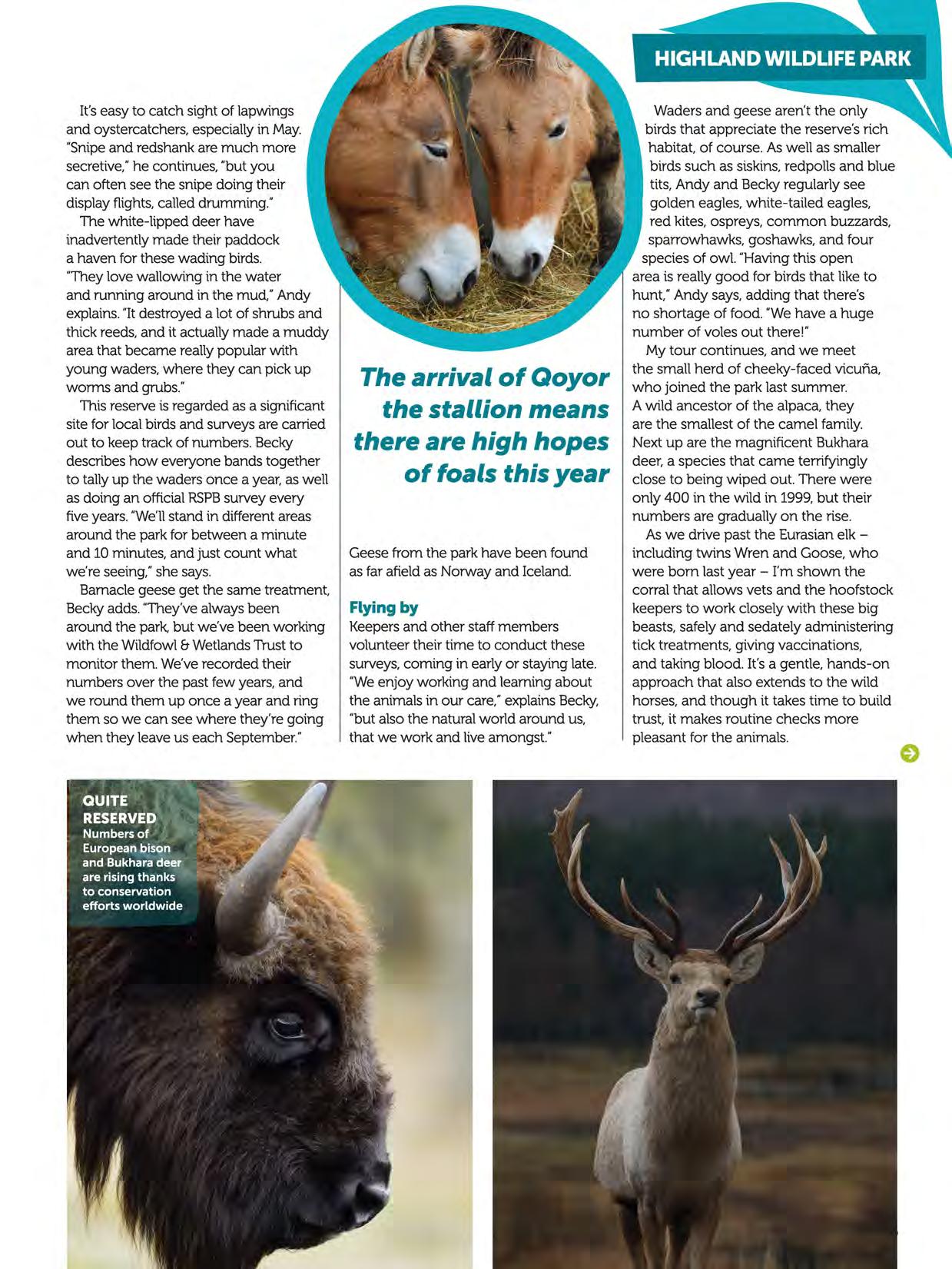
The arrival of Qoyor the stallion means there are high hopes of foals this year
Geese from the park have been found as far afield as Norway and Iceland.
Flying by Keepers and other staff members volunteer their time to conduct these surveys, coming in early or staying late. "We enjoy working and learning about the animals in our care," explains Becky, "but also the natural world around us, that we work and live amongst."
Waders and geese aren't the only birds that appreciate the reserve's rich habitat, of course. As well as smaller birds such as siskins, redpolls and blue tits, Andy and Becky regularly see golden eagles, white-tailed eagles, red kites, ospreys, common buzzards, sparrowhawks, goshawks, and four species of owl. "Having this open area is really good for birds that like to hunt," Andy says, adding that there's no shortage of food. "We have a huge number of voles out there!"
My tour continues, and we meet the small herd of cheeky-faced vicufta, who joined the park last summer. A wild ancestor of the alpaca, they are the smallest of the camel family. Next up are the magnificent Bukhara deer, a species that came terrifyingly close to being wiped out. There were only 400 in the wild in 1999, but their numbers are gradually on the rise.
As we drive past the Eurasian elkincluding twins Wren and Goose, who were born last year -I'm shown the corral that allows vets and the hoofstock keepers to work closely with these big beasts, safely and sedately administering tick treatments, giving vaccinations, and taking blood. It's a gentle, hands-on approach that also extends to the wild horses, and though it takes time to build trust, it makes routine checks more pleasant for the animals.
I notice a curious-looking tree sticking up from the ground. This is my cue to ask Andy if there's any truth in the rumour that he can often be seen dragging entire trees across the reserve. He laughs as he reveals why.
"The elk only eat browse; they don't do any grazing or eat hay -they like bark. branches. needles and leaves. So a big part of our day is ensuring that we get fresh browse for them."
It's then placed upright to imitate the way trees grow. The browse comes from on-site plantations. or trees donated by the local community. The arrival of the day's woody offerings is a good time to get a glimpse of the elk. who have a reputation for being hard to find.

Growing wild
Conservation project officer Carl Allott joins us to share the park's biodiversity goals. giving me an insight into the staggering amount of work that goes on behind the scenes to protect and promote rare species at the reserve.
Not all of it is immediately obvious to onlookers. but this year the opening of Scotland's WildlifeDiscovery Centre at the park will help visitors learn more about this vital conservation of our native flora and fauna.
Carl points out verges that were once cut short. now filled with thousands
Keepers Andy Tonge and Becky Pink prepare fresh browse for the park's Eurasian elk (below)
Some Przewalski's horses have bider markings, which look like dark, symmetrical stains on each shoulder. These rare primitive marks are unique to native Mongolian horses.
of bulbs. We pass aspen trees that not only have a rare lichen growing on them, but could also attract rare invertebrates in the future, such as the endangered dark bordered beauty moth that's bred off-show at the park. Even the hoofstock browse is grown and cut more sustainably now and masses of wildflowers have been planted to entice a wild range of invertebrates.
Some projects take longer than others. Working alongside the Cairngorms
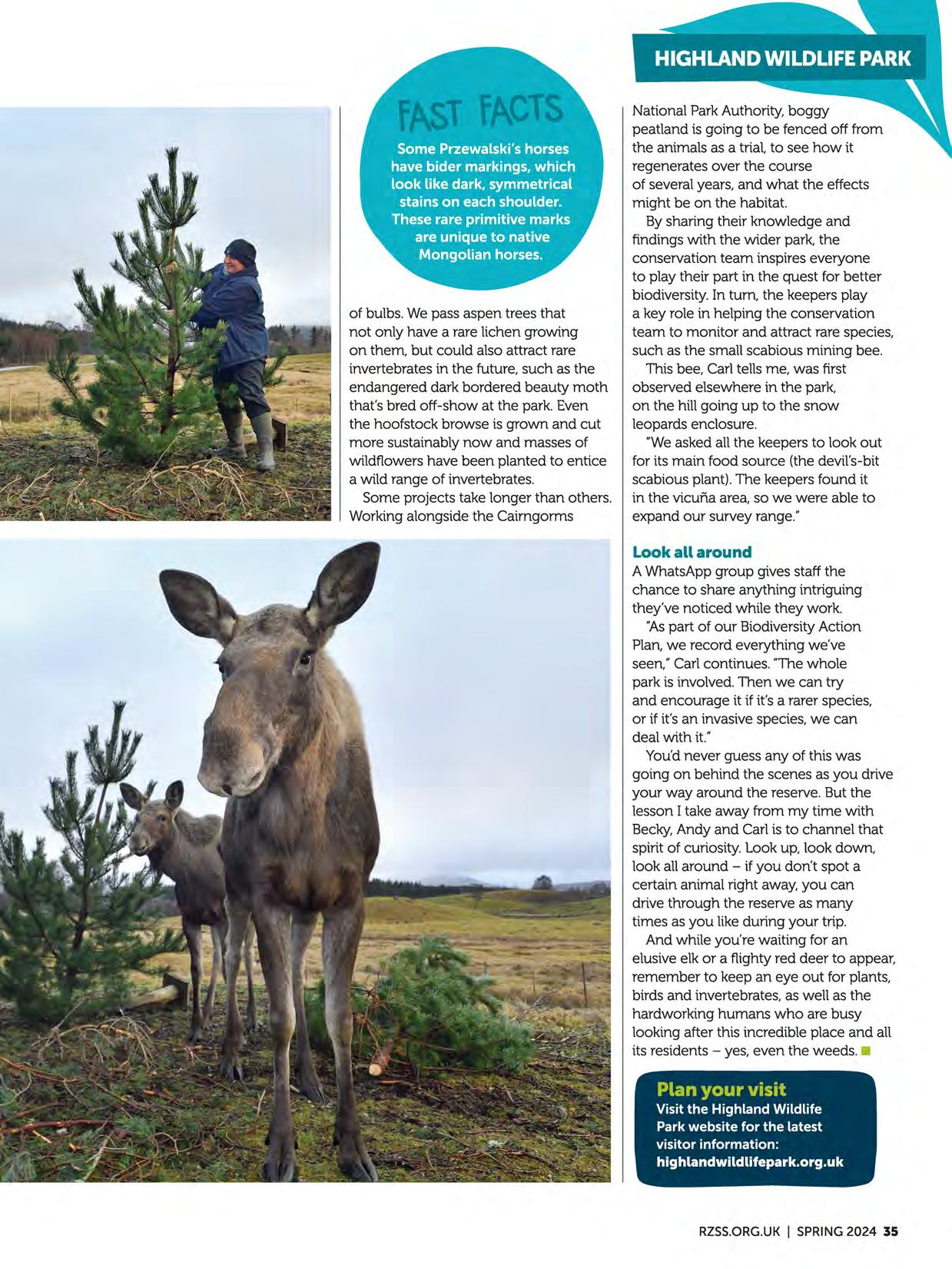
National Park Authority, boggy peatland is going to be fenced off from the animals as a trial, to see how it regenerates over the course of several years, and what the effects might be on the habitat.
By sharing their knowledge and findings with the wider park, the conservation team inspires everyone to play their part in the quest for better biodiversity. In turn, the keepers play a key role in helping the conservation team to monitor and attract rare species, such as the small scabious mining bee.
This bee, Carl tells me, was first observed elsewhere in the park, on the hill going up to the snow leopards enclosure.
"We asked all the keepers to look out for its main food source (the devil's-bit scabious plant). The keepers found it in the vicufi.aarea, so we were able to expand our survey range."
Look all around
A WhatsApp group gives staff the chance to share anything intriguing they've noticed while they work.
"Aspart of our BiodiversityAction Plan, we record everything we've seen," Carl continues. "The whole park is involved. Then we can try and encourage it if it's a rarer species, or if it's an invasive species, we can deal with it."
You'd never guess any of this was going on behind the scenes as you drive your way around the reserve. But the lesson I take away from my time with Becky,Andy and Carl is to channel that spirit of curiosity. Look up, look down, look all around -if you don't spot a certain animal right away, you can drive through the reserve as many times as you like during your trip.
And while you're waiting for an elusive elk or a flighty red deer to appear, remember to keep an eye out for plants, birds and invertebrates, as well as the hardworking humans who are busy looking after this incredible place and all its residents -yes, even the weeds.
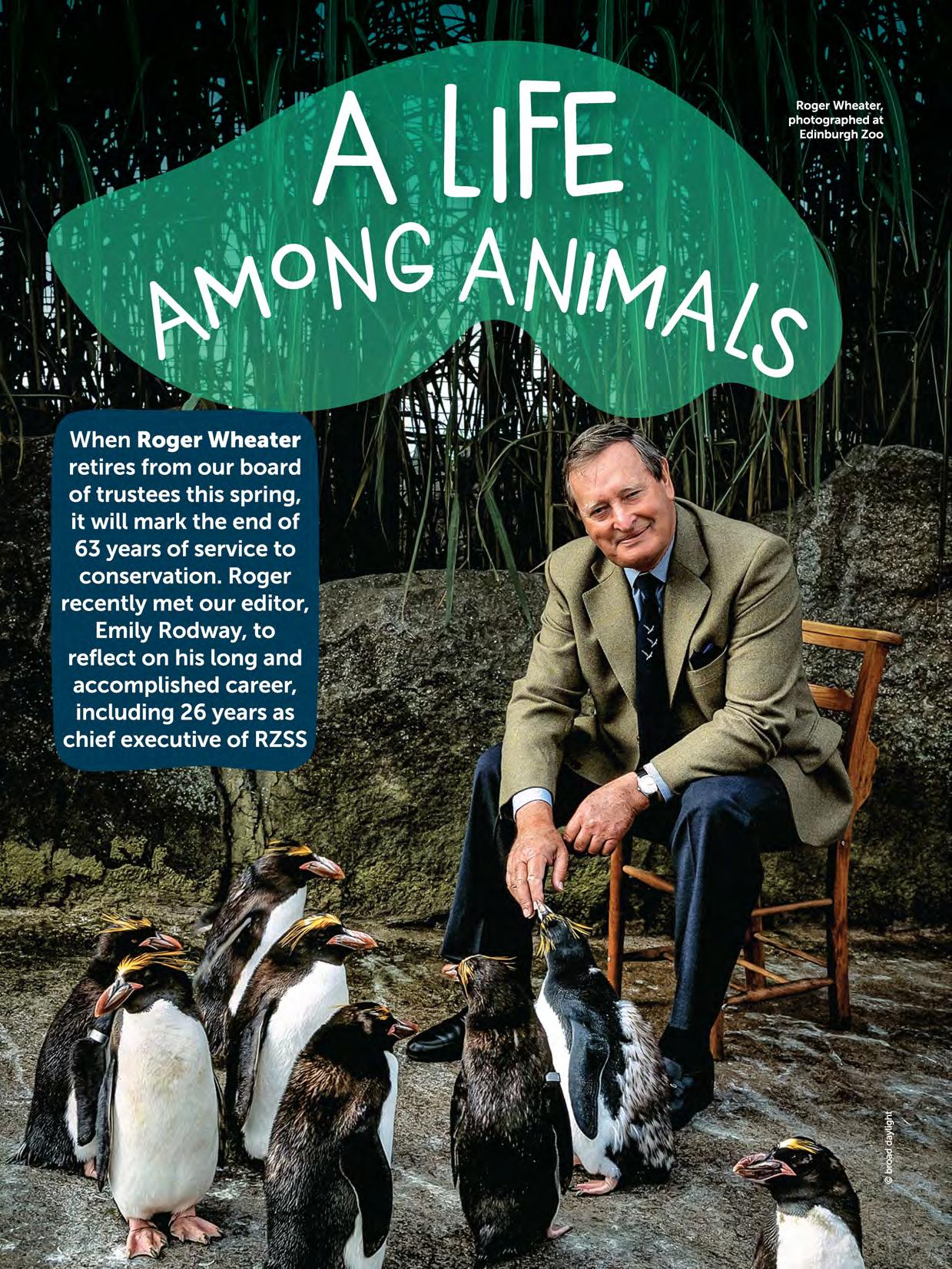
My interest in wildlife started as a teenager," recalls RZSS trustee Roger Wheater.
casting his mind back some 75 years. "I collected butterflies and caterpillars. At one stage I had over 100 species in my bedroom; you could hear the bigger ones munching at night."
Imagine that teenage boy's reaction if he'd been able to look into the future to see the career ahead of him -and the many species of animals that he'd be working alongside -firstly in Uganda at Murchison FallsNational Park and later. for many decades. here in Scotland.
The other stand-out memory from his youth was a book -Sir Samuel White Baker's Albert N'yanza, Great Basin of the Nile. Baker's account of his 1851-5 Nile expedition captured young Roger's imagination and. when he was later asked where he would like to travel for his National Service, his answer was Africa.
After completing National Service in the Royal West African Frontier Force. Roger briefly returned to the UKbefore joining the colonial police in Uganda for five years. He then fulfilleda longterm ambition to work with Uganda's magnificent wildlife,becoming chief warden of Murchison Falls National Park Extending over 1,500 square miles of land and bisected by the Nile. the population included 14,000 elephants and 32,000
''The only way to really make progress on supporting species that are at risk is through coordinated activity"
Roger Wheater, trustee and retired chief executiveof RZSS buffalo, black rhino and rare northern white rhino that had been brought into the area for their protection.
Alongside these wild animals. Roger remembers three individuals that were under his care when he took on the job. There was a puff adder called Prunella, a "very noisy" African grey parrot. and a baby rhino that was eventually released back into the wild -although she never quite lost her desire for human company, and would always come out to greet him when he was touring the bush after her release, even bringing her calf in tow.
As well as overseeing the welfare of a vast number of wild animals. the job of chief warden also involved managing a staff of some 250 people. looking after VIP visitors, and overseeing educational facilities and staff for visiting schoolchildren. It was all great training for the two high-profile roles that were to come next -the first. an 18-month spell as director of Uganda National Parks.
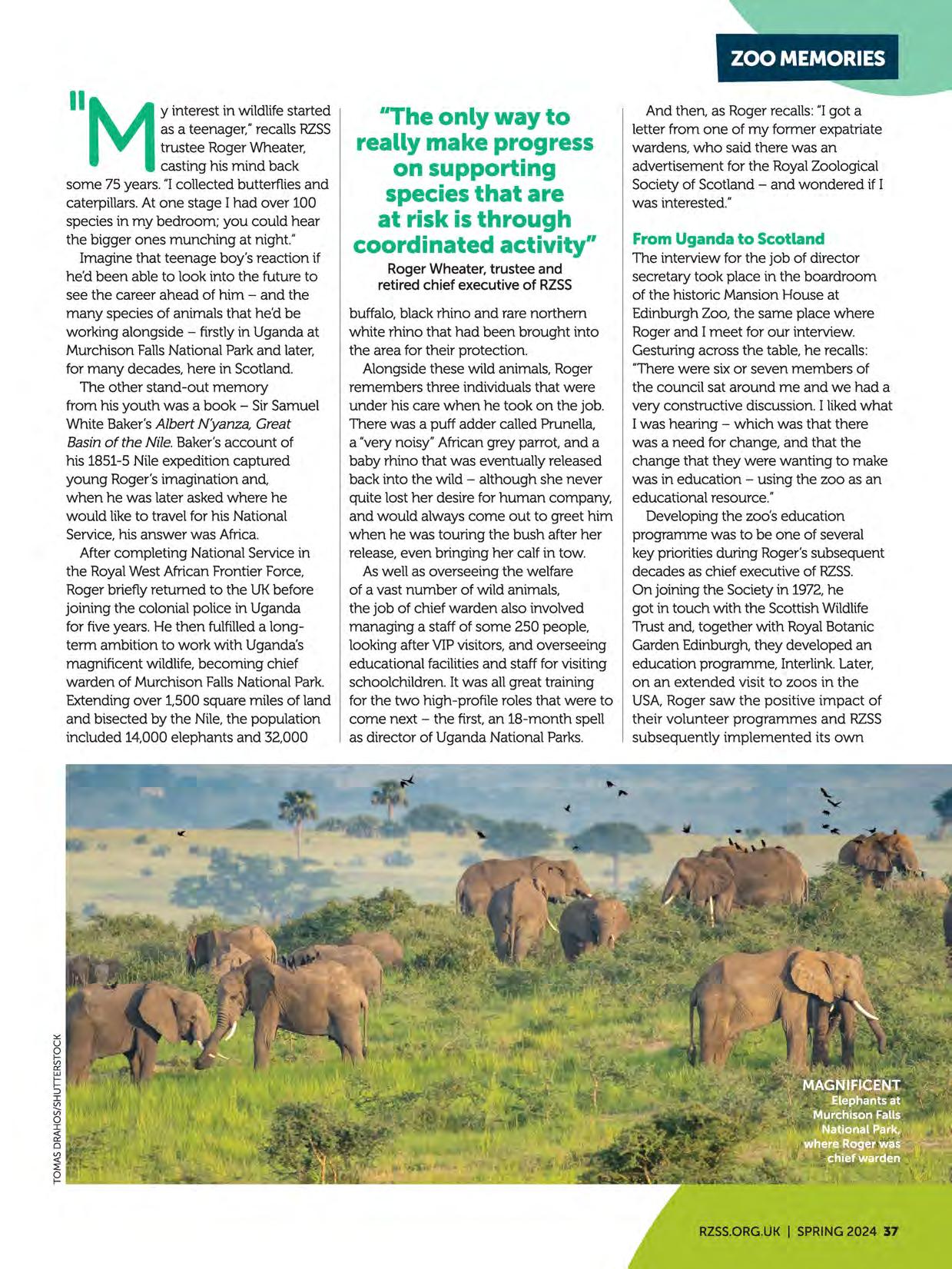
And then, as Roger recalls: "I got a letter from one of my former expatriate wardens. who said there was an advertisement for the Royal Zoological Society of Scotland -and wondered if I was interested."
The interview for the job of director secretary took place in the boardroom of the historic Mansion House at Edinburgh Zoo, the same place where Roger and I meet for our interview. Gesturing across the table. he recalls: "There were six or seven members of the council sat around me and we had a very constructive discussion. I liked what I was hearing -which was that there was a need for change, and that the change that they were wanting to make was in education -using the zoo as an educational resource."
Developing the zoo's education programme was to be one of several key priorities during Roger's subsequent decades as chief executive of RZSS. On joining the Society in 1972,he got in touch with the Scottish Wildlife Trust and. together with Royal Botanic Garden Edinburgh, they developed an education programme. Interlink.Later. on an extended visit to zoos in the USA,Roger saw the positive impact of their volunteer programmes and RZSS subsequently implemented its own
equivalent, benefiting both Edinburgh Zoo and Highland WildlifePark.
"We're now understanding all these years later that the only way to really make any kind of progress on supporting species that are at risk is through coordinated activity,"Roger explains. "I also remember, around this very table, meeting with the directors of all the British charitable zoos, to discuss how we were going to manage the animals in our care collectively."
Nowadays, zoos across Europe collaborate to sustain a healthy animal population through breeding programmes. But at the time, this approach was innovative. Allthe zoo representatives present at the Mansion House meeting (with the exception of
DAVID AND ROGERIn the boardroom with
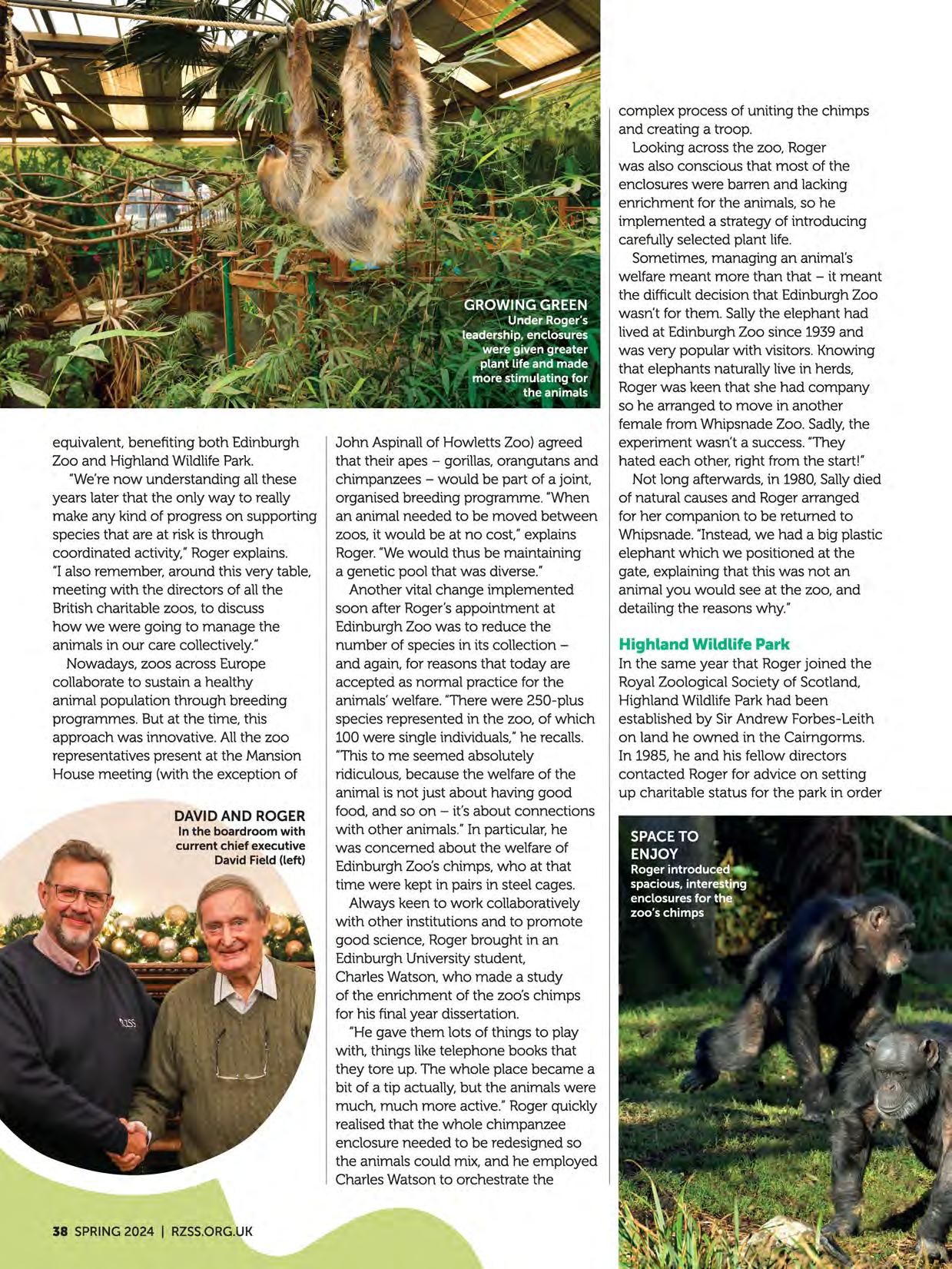
John Aspinall of Howletts Zoo) agreed that their apes -gorillas, orangutans and chimpanzees -would be part of a joint, organised breeding programme. "When an animal needed to be moved between zoos, it would be at no cost," explains Roger. "Wewould thus be maintaining a genetic pool that was diverse."
Another vital change implemented soon after Roger's appointment at Edinburgh Zoo was to reduce the number of species in its collectionand again, for reasons that today are accepted as normal practice for the animals' welfare. "There were 250-plus species represented in the zoo, of which 100 were single individuals,"he recalls. "This to me seemed absolutely ridiculous, because the welfare of the animal is not just about having good food, and so on - it's about connections with other animals." In particular, he was concerned about the welfare of Edinburgh Zoo's chimps, who at that time were kept in pairs in steel cages.
Always keen to work collaboratively with other institutions and to promote good science, Roger brought in an Edinburgh University student, Charles Watson, who made a study of the enrichment of the zoo's chimps for his final year dissertation.
"He gave them lots of things to play with, things like telephone books that they tore up. The whole place became a bit of a tip actually, but the animals were much, much more active." Roger quickly realised that the whole chimpanzee enclosure needed to be redesigned so the animals could mix, and he employed Charles Watson to orchestrate the
complex process of uniting the chimps and creating a troop.
Looking across the zoo, Roger was also conscious that most of the enclosures were barren and lacking enrichment for the animals, so he implemented a strategy of introducing carefully selected plant life.
Sometimes, managing an animal's welfare meant more than that -it meant the difficult decision that Edinburgh Zoo wasn't for them. Sally the elephant had lived at Edinburgh Zoo since 1939 and was very popular with visitors. Knowing that elephants naturally live in herds, Roger was keen that she had company so he arranged to move in another female from Whipsnade Zoo. Sadly,the experiment wasn't a success. "They hated each other, right from the start!"
Not long afterwards, in 1980, Sally died of natural causes and Roger arranged for her companion to be returned to Whipsnade. "Instead, we had a big plastic elephant which we positioned at the gate, explaining that this was not an animal you would see at the zoo, and detailing the reasons why."
In the same year that Roger joined the Royal Zoological Society of Scotland, Highland Wildlife Park had been established by Sir Andrew Forbes-Leith on land he owned in the Cairngorms. In 1985, he and his fellow directors contacted Roger for advice on setting up charitable status for the park in order
to ensure its future. Eventually, it was decided that the park and its collection would come under RZSSmanagement.
In the early years, Highland Wildlife Park only held species native to Scotland, including those that are now extinct in this country such as bison and lynx. Nowadays, it includes wider wildlife of the northern hemisphere, meaning that RZSScan provide roomy enclosures for animals such as polar bears in a climate similar to the one they would enjoy in the wild.
Roger has been pleased to see the increase in visitor numbers to the park over the years and is delighted by the prospect of the forthcoming Scotland's Wildlife Discovery Centre, opening later this spring, which he describes as "Absolutely marvellous!"
Looking all the way back to the initiatives he spearheaded to educate Ugandan primary school children about their local wildlife, he explains why education initiatives like this have always been a key focus for the organisations he has worked across. "Ifpeople don't believe that wildlife has any reference to their lives, then you won't get any support. But if you get them to understand at a very young age, then they will support it, and that has proved to be the case."
Roger retired as CEO of RZSSin 1998 but was invited back to help steer the running of the charity in 2011 and has been on the board of trustees ever since. At the age of 90, he is finally
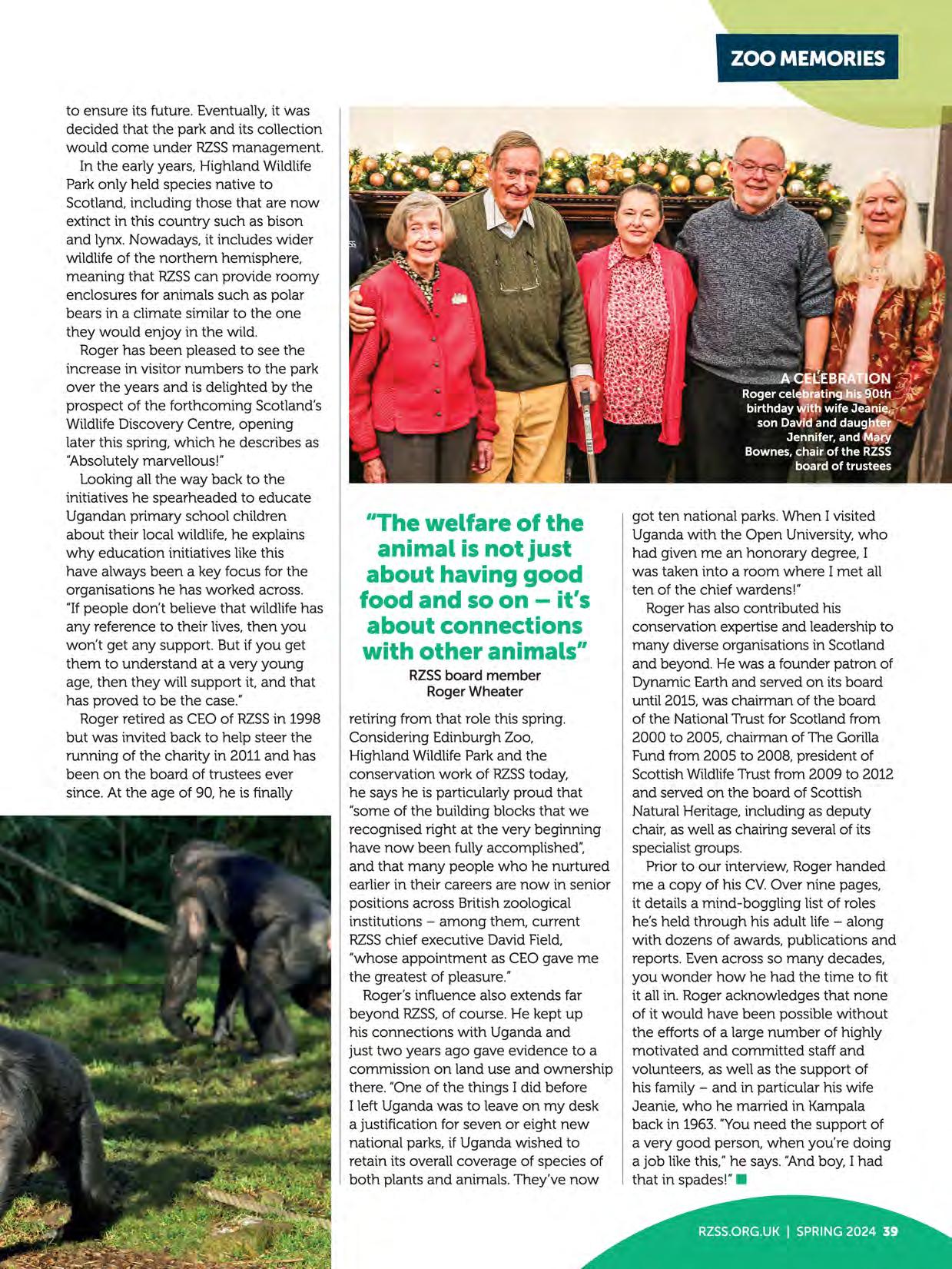
11 The welfare of the animal is not just about having good food and so on -it's about connections with other animals"
RZSS board member Roger Wheater
retiring from that role this spring. Considering Edinburgh Zoo, Highland Wildlife Park and the conservation work of RZSStoday, he says he is particularly proud that "some of the building blocks that we recognised right at the very beginning have now been fully accomplished", and that many people who he nurtured earlier in their careers are now in senior positions across British zoological institutions -among them, current RZSSchief executive David Field, "whose appointment as CEO gave me the greatest of pleasure."
Roger's influence also extends far beyond RZSS,of course. He kept up his connections with Uganda and just two years ago gave evidence to a commission on land use and ownership there. "One of the things I did before I left Uganda was to leave on my desk a justification for seven or eight new national parks, if Uganda wished to retain its overall coverage of species of both plants and animals. They've now
got ten national parks. When I visited Uganda with the Open University, who had given me an honorary degree, I was taken into a room where I met all ten of the chief wardens!"
Roger has also contributed his conservation expertise and leadership to many diverse organisations in Scotland and beyond. He was a founder patron of Dynamic Earth and served on its board until 2015, was chairman of the board of the National Trust for Scotland from 2000 to 2005, chairman of The Gorilla Fund from 2005 to 2008, president of Scottish WildlifeTrust from 2009 to 2012 and served on the board of Scottish Natural Heritage, including as deputy chair, as well as chairing several of its specialist groups.
Prior to our interview, Roger handed me a copy of his CV.Over nine pages, it details a mind-boggling list of roles he's held through his adult life -along with dozens of awards, publications and reports. Even across so many decades, you wonder how he had the time to fit it all in. Roger acknowledges that none of it would have been possible without the efforts of a large number of highly motivated and committed staff and volunteers, as well as the support of his family -and in particular his wife Jeanie, who he married in Kampala back in 1963. "Youneed the support of a very good person, when you're doing a job like this," he says. "And boy, I had that in
With their sassy attitude and striking head feathers, the rockies at Edinburgh Zoo are our undisputed champs

Edinburgh's Northern rockhoppers -or rockies, as we affectionately call themare the smallest penguin species at the zoo, growing to around 55cm. They live at Penguins Rock with our gentoo and king penguins, splashing around in Europe's biggest outdoor penguin pool.
There are no prizes for guessing how these nimble penguins got their name. They're built to hop from rock to rock on remote, rugged islands, and they can scale a steep cliff with astonishing agility, keeping their feet together as they bounce. When they're not nesting, they spend up to six months at sea.
That flamboyant 'eyebrow' of yellow feathers is known as a supercilium. Head-shaking is an important part of a rockhopper's courtship, and an eye-catching whirl of yellow helps attract their mate. You'll notice that juveniles take a wee while to reach bushy-browed splendour, but do eventually catch up!
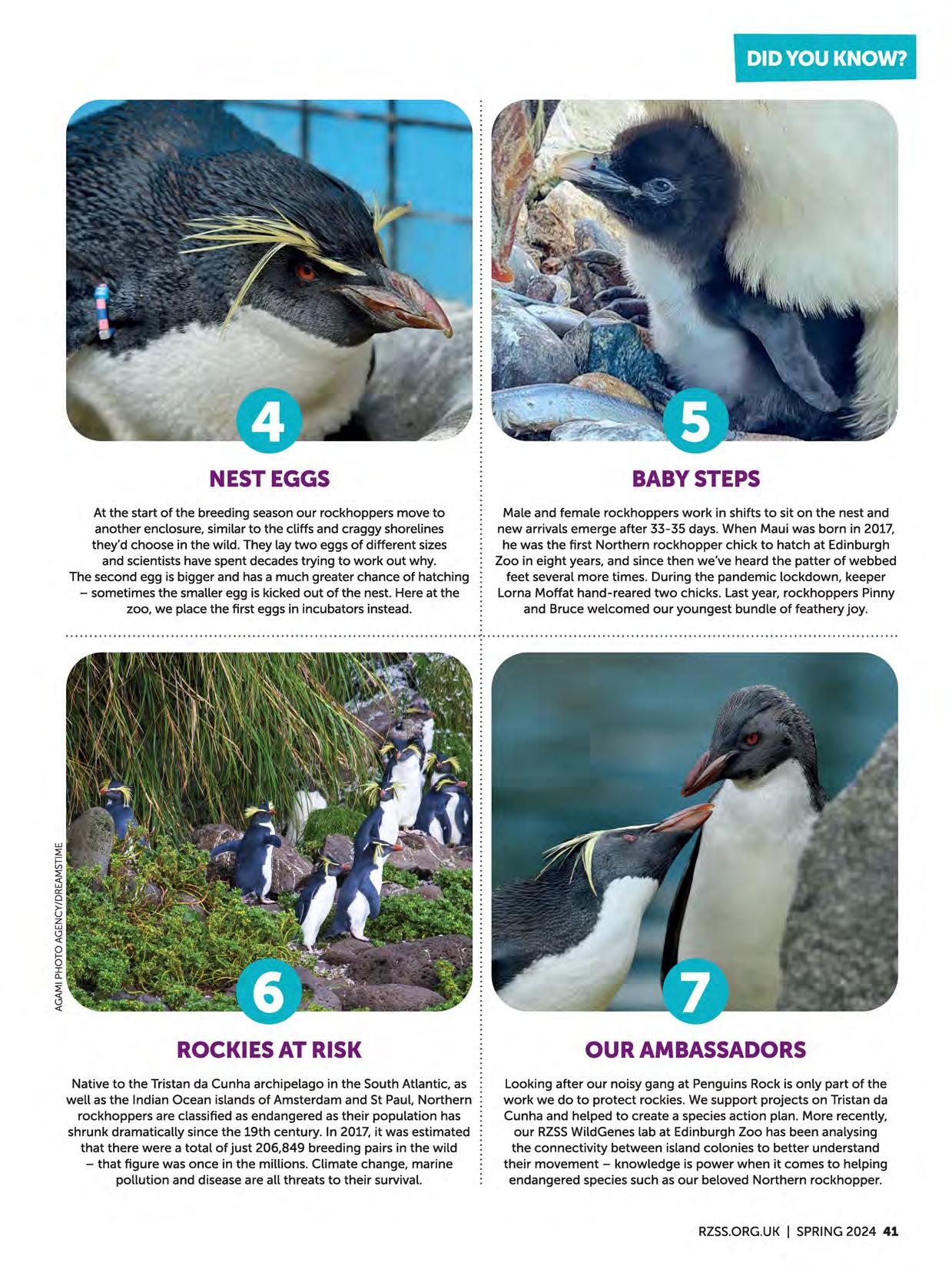
At the start of the breeding season our rockhoppers move to another enclosure, similar to the cliffs and craggy shorelines they'd choose in the wild. They lay two eggs of different sizes and scientists have spent decades trying to work out why. The second egg is bigger and has a much greater chance of hatching -sometimes the smaller egg is kicked out of the nest. Here at the zoo, we place the first eggs in incubators instead.
Male and female rockhoppers work in shifts to sit on the nest and new arrivals emerge after 33-35 days. When Maui was born in 2017, he was the first Northern rockhopper chick to hatch at Edinburgh Zoo in eight years, and since then we've heard the patter of webbed feet several more times. During the pandemic lockdown, keeper Lorna Moffat hand-reared two chicks. Last year, rockhoppers Pinny and Bruce welcomed our youngest bundle of feathery joy.
Native to the Tristan da Cunha archipelago in the South Atlantic, as well as the Indian Ocean islands of Amsterdam and St Paul. Northern rockhoppers are classified as endangered as their population has shrunk dramatically since the 19th century. In 2017, it was estimated that there were a total of just 206,849 breeding pairs in the wild -that figure was once in the millions. Climate change, marine pollution and disease are all threats to their survival.
Looking after our noisy gang at Penguins Rock is only part of the work we do to protect rockies. We support projects on Tristan da Cunha and helped to create a species action plan. More recently, our RZSSWildGenes lab at Edinburgh Zoo has been analysing the connectivity between island colonies to better understand their movement -knowledge is power when it comes to helping endangered species such as our beloved Northern rockhopper.
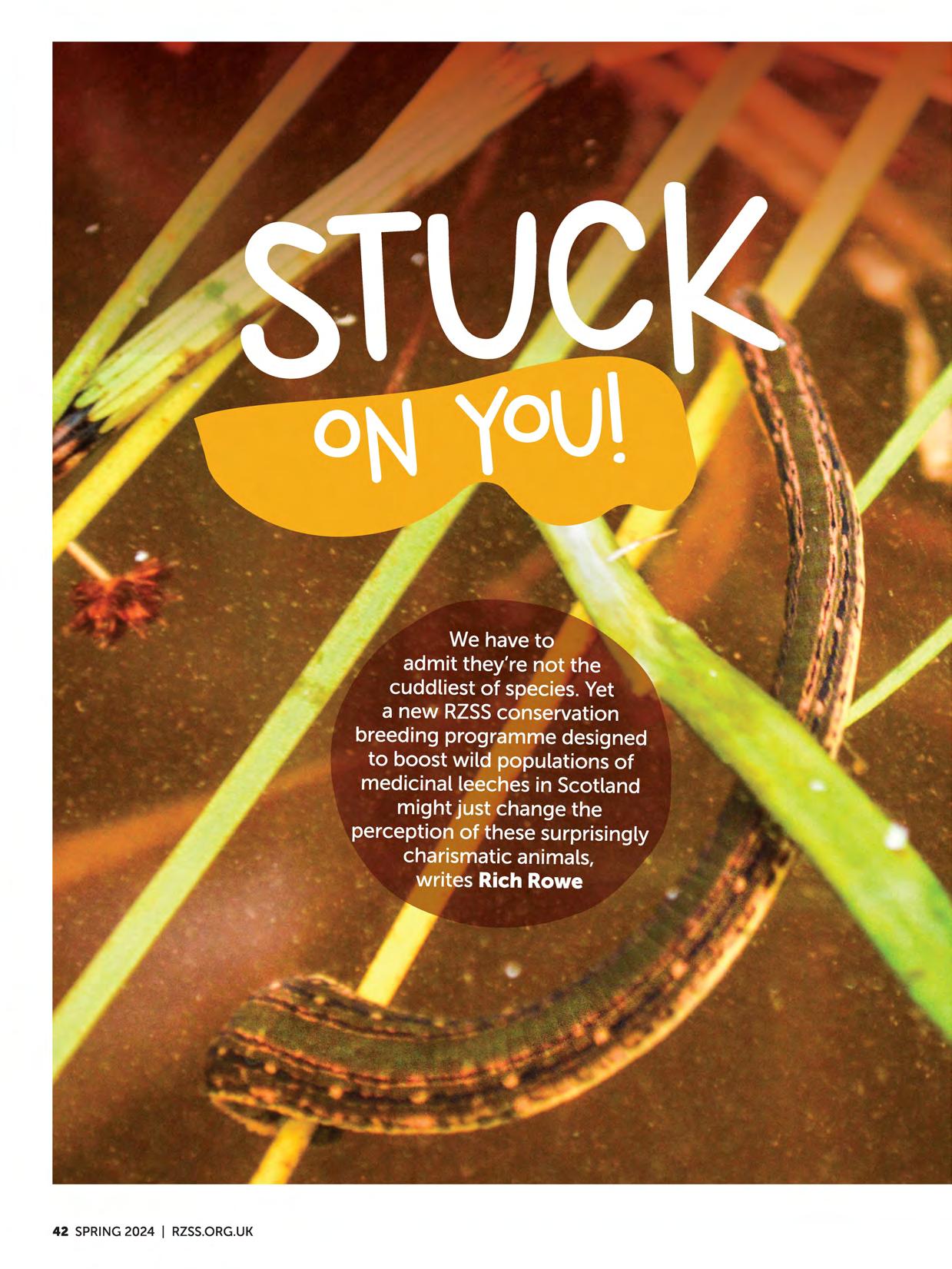
n their own miniature way, medicinal leeches are the Scottish equivalent of crocodiles that hunt at a waterhole. Attracted by the splashing of deer, cattle and sheep at the water's edge, the leeches swim towards their potential hosts and latch on using a sucker before biting with interlocking teeth. They feed on a blood meal until, full and bloated, they drop off -their prey, unlike in a crocodile strike, often left none the wiser.
For many it's a gruesome image, and even the word 'leech' is enough to make some recoil. But while she's the first to admit that some species are a tougher sell than others, Dr Helen Taylor, conservation programme manager at RZSS, has become rather fond of them. "Yes, they have a grisly side and are never going to be seen as cute, but leeches are fascinating creatures," she says.
Medicinal leeches are the latest invertebrates to be the subject of a long-term conservation breeding programme at Highland Wildlife Park. A collaborative effort, the work is being coordinated together with Buglife Scotland and Species on the Edge, a programme run by NatureScot in

conjunction with a range of nature conservation charities. The programme has a particular focus on restoring the fortunes of 37 priority species found along Scotland's coast and islands, including the medicinal leech.
More often associated with tropical climes, there are actually 17 species of leech found in the UK.A type of worm that spends the majority of its time in freshwater, most leeches are
11 They are never going to be seen as cute, but leeches are fascinating creatures"
Conservation Programme Manager
Dr Helen Taylor
no bigger than a thumbnail, with jaws only strong enough to feed on other invertebrates or dead and dying amphibians. The medicinal leech, however, is a different beast altogether. One of the largest species found in the UK growing up to 20cm in length, it is equipped with two suckers which are used as leverage to move, and of course those strong teeth.
The medicinal leech also has yellow stripes down its sides and variable speckled patterns on its underside. Those found in Scotland typically have a darker colouration than their relatives in England.
Humans and leeches have a relationship that dates back centuries, with the parasitic worm long considered highly valuable rather than repugnant. Wild populations throughout Europe were once harvested in their millions for use by physicians who believed that bloodletting with leeches balanced the body's 'humours' and helped cure a variety of illnesses.
In one of his works, the romantic poet William Wordsworth described the solitary life of a leech gatherer: 0
an old man whose job it was to gather leeches by wading bare-legged in marshes, using his legs as bait. More often, however, leech gathering was considered a female occupation, with women's softer, hairless skin thought to be more attractive to leeches.
"There is so much cultural history associated with leeches," says Helen. "Since starting the programme, we've had people get in touch to share memories of their grandparents being treated with leeches."
In fact, the use of leeches in medicine has recently seen a renaissance. Several NHS consultants across the UK have reintroduced leech therapy for use with trauma patients to help improve blood flow in tissue that has poor circulation. Once attached to the site, leech saliva provides local anaesthesia, antihistamine and natural anticoagulants that prevent clotting.
Such leeches, however, are a 0 Mediterranean vanety, specially farmed in Wales, rather than medicinal leeches which are legally protected in the UK
due to their scarcity -a result not just of overharvesting but also habitat loss and freshwater pollution.
Part of the challenge is that they require a 'Goldilocks' habitat. Everything has to be just right: clean, sheltered and still water that is shallow enough to heat up in the sunshine; rocks around the water's edge on which to lay cocoons of eggs; amphibians on which the young can feed; plus large mammals coming to the water to provide adults with a blood meal.
Today, medicinal leeches are found in only a handful of locations around the UK and until recently just two sites in Scotland: a freshwater lochan on Islay, plus a series of larger lochs just north of Oban. In late 2023, a third population was confirmed in Dumfries and Galloway by Craig Macadam, conservation director at Buglife Scotland, who has made tracking down additional populations of medicinal leeches a personal mission.
At the heart of his investigation has been some clever cultural detective work,

using a first edition Ordnance Survey map to find leech-derived place names in both Gaelic (deala) and Scots (gell or gelly)."In all, I found a dozen mentions of Lochan nan Deala and many references to them in Scots,"he says.
Craig is now around halfway through surveying the various Lochan nan Deala found on the map but has yet to discover medicinal leeches at any of the sites.
"That's why the find in Dumfries and Galloway towards the end of last year was so special,"he adds.
"Everyone laughs at me about it, but the leeches we have here all have different personalities," says Adam Button, the experienced invertebrate keeper who oversees the programme at Highland WildlifePark. "They can be incredibly inquisitive, especially when people come into the room and start moving around."
In all, a dozen leeches -all collected under licence from the site near Oban -are kept in a series of large tanks. Four of the leeches are mature adults that
the team are confident will breed this year, while the remaining eight are of intermediate age and may reach sexual maturity this year. With little in the way of past scientific study of the leech's behaviour, acute observation is a big part of Adam's job -with much to learn about breeding patterns and activity levels during the winter months.
Fortunately, Adam is no stranger to the weird and wonderful world of leeches, having come to the Highland Wildlife Park from the invertebrate department at Bristol Zoo, which had developed husbandry guidelines for a small population of medicinal leeches in its collection.
One key consideration is to keep the leeches in a naturalistic cycle to mimic how they would live in the wild. "We've also set the tanks up with as much variety as possible to understand what elements the animals prefer,"explains Adam.
As such, the tanks are equipped with features that include stacks of slate with an abundance of hiding places to explore, a soap dish full of moss stuck to the side of the tank where it is thought the leeches might lay cocoons, and even a floating island of bark with a covering of moss. Feeding, meanwhile, involves a bespoke kitchen set-up. Matching what the animals would feed on in the wild, the leeches are given blood taken from deer, which is then stored in a freezer.
0 Everyonelaughsat me about it, but the leeches we have here all have diHerent personalities"
ExperiencedInvertebrateKeeper
Adam Button
At feeding time, the blood is defrosted, blended to allow the cells to reform and then made into a blood sausage using collagen sausage skins. The sausage is brought up to body temperature in warm water - "If it's cold, they aren't interested," explains Adam -and then placed in with the leeches. They are fed one at a time so that each can be weighed and measured before and after feeding. The amount of blood they take
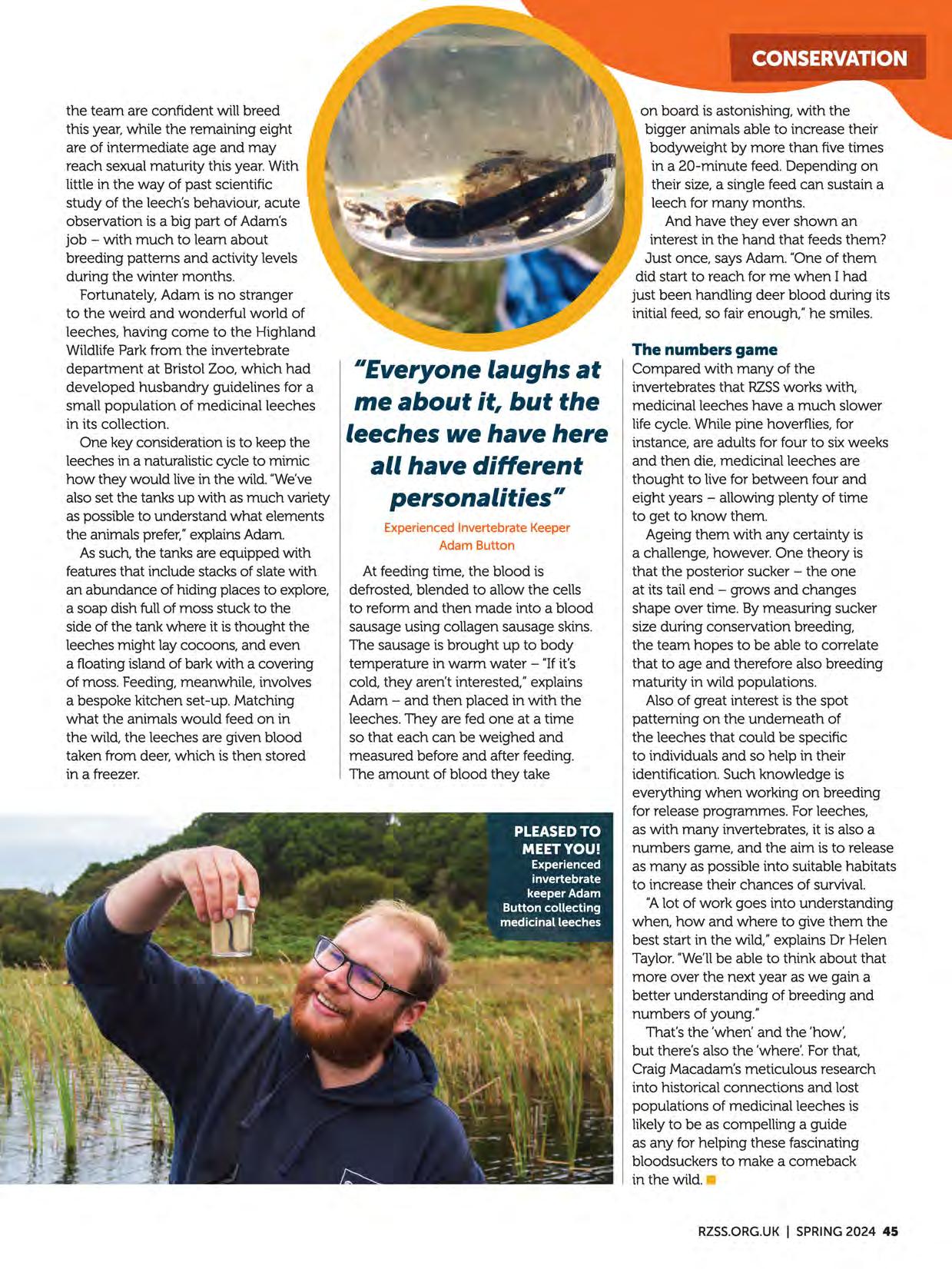
on board is astonishing, with the bigger animals able to increase their bodyweight by more than five times in a 20-minute feed. Depending on their size, a single feed can sustain a leech for many months.
And have they ever shown an interest in the hand that feeds them?
Just once, says Adam. "One of them did start to reach for me when I had just been handling deer blood during its initial feed, so fair enough," he smiles.
Compared with many of the invertebrates that RZSSworks with, medicinal leeches have a much slower life cycle. While pine hoverflies, for instance, are adults for four to six weeks and then die, medicinal leeches are thought to live for between four and eight years -allowing plenty of time to get to know them.
Ageing them with any certainty is a challenge, however. One theory is that the posterior sucker -the one at its tail end -grows and changes shape over time. By measuring sucker size during conservation breeding, the team hopes to be able to correlate that to age and therefore also breeding maturity in wild populations.
Also of great interest is the spot patterning on the underneath of the leeches that could be specific to individuals and so help in their identification. Such knowledge is everything when working on breeding for release programmes. For leeches, as with many invertebrates, it is also a numbers game, and the aim is to release as many as possible into suitable habitats to increase their chances of survival.
"Alot of work goes into understanding when, how and where to give them the best start in the wild," explains Dr Helen Taylor."We'llbe able to think about that more over the next year as we gain a better understanding of breeding and numbers of young."
That's the 'when' and the 'how', but there's also the 'where'. For that, Craig Macadam's meticulous research into historical connections and lost populations of medicinal leeches is likely to be as compelling a guide as any for helping these fascinating bloodsuckers to make a comeback in the wild.
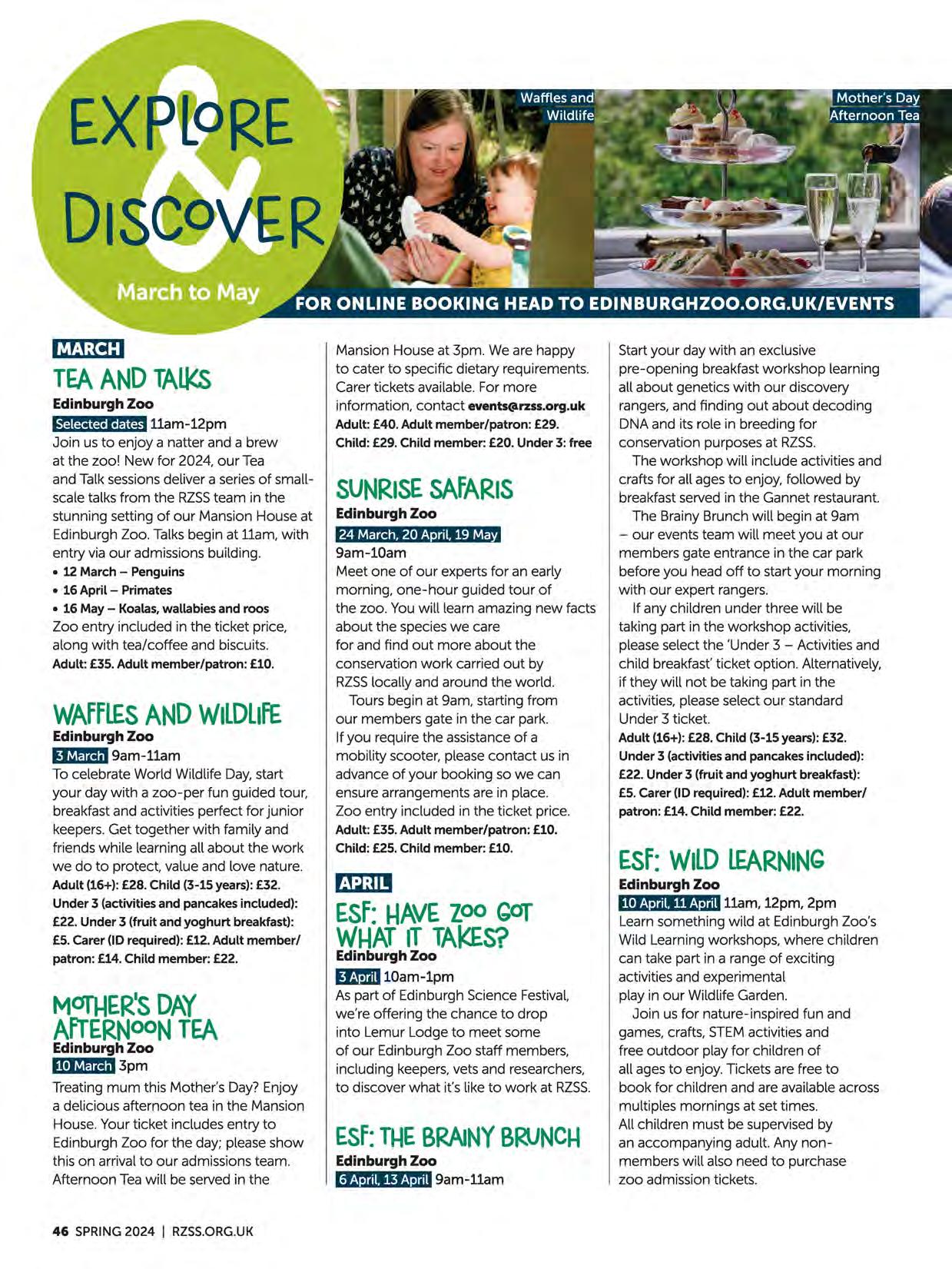
Edinburgh Zoo
i-ii@!tffirUflffi11am-12pm
Join us to enjoy a natter and a brew at the zoo! New for 2024, our Tea and Talk sessions deliver a series of smallscale talks from the RZSSteam in the stunning setting of our Mansion House at Edinburgh Zoo. Talks begin at 11am, with entry via our admissions building.
• 12 March- Penguins
• 16 April- Primates
• 16 May- Koalas,wallabiesand roos Zoo entry included in the ticket price, along with tea/coffee and biscuits. Adult:£35.Adultmember/patron:£10.
Edinburgh Zoo
9am-11am
To celebrate World Wildlife Day, start your day with a zoo-per fun guided tour, breakfast and activities perfect for junior keepers. Get together with family and friends while learning all about the work we do to protect, value and love nature. Adult(16+):£28. Child(3-15years):£32. Under3 (activitiesand pancakesincluded): £22. Under3 (fruitandyoghurtbreakfast): £5. Carer(ID required):£12.Adultmember/ patron:£14.Childmember:£22.
Edinburgh Zoo
luHfflN3pm
Treating mum this Mother's Day? Enjoy a delicious afternoon tea in the Mansion House. Your ticket includes entry to Edinburgh Zoo for the day; please show this on arrival to our admissions team. Afternoon Tea will be served in the
Mansion House at 3pm. We are happy to cater to specific dietary requirements. Carer tickets available. For more information, contact events@rzss.org.uk Adult:£40. Adultmember/patron:£29. Child:£29.Childmember:£20. Under3: free
Edinburgh Zoo
24 March,20 April,19 May 9am-10am
Meet one of our experts for an early morning, one-hour guided tour of the zoo. You will learn amazing new facts about the species we care for and find out more about the conservation work carried out by RZSSlocally and around the world.
Tours begin at 9am, starting from our members gate in the car park. If you require the assistance of a mobility scooter, please contact us in advance of your booking so we can ensure arrangements are in place. Zoo entry included in the ticket price. Adult:£35.Adultmember/patron:£10. Child:£25.Childmember:£10.
Edinburgh Zoo m!DI] 10am-1pm
As part of Edinburgh Science Festival, we're offering the chance to drop into Lemur Lodge to meet some of our Edinburgh Zoo staff members, including keepers, vets and researchers, to discover what it's like to work at RZSS.
Start your day with an exclusive pre-opening breakfast workshop learning all about genetics with our discovery rangers, and finding out about decoding DNA and its role in breeding for conservation purposes at RZSS.
The workshop will include activities and crafts for all ages to enjoy, followed by breakfast served in the Gannet restaurant.
The Brainy Brunch will begin at 9am -our events team will meet you at our members gate entrance in the car park before you head off to start your morning with our expert rangers.
If any children under three will be taking part in the workshop activities, please select the 'Under 3 -Activities and child breakfast' ticket option. Alternatively, if they will not be taking part in the activities, please select our standard Under 3 ticket.
Adult(16+):£28. Child(3-15years):£32. Under3 (activitiesand pancakesincluded): £22. Under3 (fruitandyoghurtbreakfast): £5. Carer(ID required):£12.Adultmember/ patron:£14.Childmember:£22.
Edinburgh Zoo
10 April,11April 11am, 12pm, 2pm
Learn something wild at Edinburgh Zoo's Wild Learning workshops, where children can take part in a range of exciting activities and experimental play in our Wildlife Garden.
Edinburgh Zoo iMlifM 9am-11am
Join us for nature-inspired fun and games, crafts, STEM activities and free outdoor play for children of all ages to enjoy. Tickets are free to book for children and are available across multiples mornings at set times. All children must be supervised by an accompanying adult. Any nonmembers will also need to purchase zoo admission tickets.
Edinburgh Zoo EBNllltM
Celebrating International Compost Awareness Week 2024, we've got designated windows for picking up some of our very own Edinburgh Zoo animal manure on the mornings of Wednesday 8 May and Saturday 11 May. Please book your collection via eventbrite. £5 per SOL.
Edinburgh Zoo
18 May, 19 May 10:30am-3pm
Make sure to stop by Lemur Lodge this weekend to visit our spring market. Along with our plant sale and stalls from local traders, we will also be hosting talks from our own gardeners to help you get your garden and plants ready for summer. Talks will be ticketed, but the market is free with zoo entry.

Edinburgh Zoo
8 April, 9 April, 27 June, 28 June, 29 Jul , 2 September, 3 September, 3 October, 4 October
Wildlife photographer Laurie Campbell returns with his Nature Photography Workshops. These full-day events consist of tutorials as well as a tour of Edinburgh Zoo.
Adult: £155. Member or patron: £140.
Edinburgh Zoo EEll!lL!J9am-1pm
The perfect experience for budding photographers, this workshop is tailored for children aged 11-15. It will help them develop their wildlife photography skills under the expert guidance of Laurie Campbell. £85. Member: £78.
COMING SOON! We're excited to be launching our much-loved Nature Photography Workshops at Highland Wildlife Park this year. Check our website or email events@rzss.org.uk to join a list to be first to hear.
Edinburgh Zoo tJ.iltM
Join us for a fun-filled day as cheeky favourites from Peppa Pig bring their playful presence to the zoo. You will have the chance to see Peppa and her brother George on the main lawn at intervals throughout the day -don't forget to bring your camera!
• 11am- Meet and greet
• 12:30pm- Storytime
• 2pm - Meet and greet
• 3:30pm - Storytime
For your chance to see the lovable favourites from Peppa Pig, admission tickets to Edinburgh Zoo are essential. Please note we do not have specific tickets for attending the meet and greets or storytime sessions. There is a designated performance area for these appearances that guests can attend on a first-come, first-served basis.
Start your day like no other by pigging out at our Piglets and Pancakes Breakfast at Edinburgh Zoo. Enjoy a delicious breakfast followed by fun-filled arts and crafts, as well as a guest appearance by Peppa and George from Peppa Pig!
Entry to the event is at 9am through our members gate and breakfast will be served in the Gannet restaurant. Tickets include entry to Edinburgh Zoo for the rest of the day.
Adult breakfast:£37. Adult member:£22. Child breakfast:£35. Child member:£20. Under 3 breakfast:£10.
As plants and pollinators spring into action at Edinburgh Zoo and Highland Wildlife Park, we're highlighting some of our lovely gifts that help contribute to a more biodiverse environment and support local producers

£7.50-£17.95
Seedballs have been created by conservation scientists to make growing wildflowers from seed much simpler. The balls are their own mini ecosystem, protecting seed from predators and giving them the nutrition they need to have a head start. Just pop them on top of the soil, water and watch them grow!
Seed balls are made from a unique blend of seed, clay (to fend off ants, mice and birds) peat-free compost (to give the seeds a boost) and chilli powder (an extra predator deterrent). This ancient technique of seed propagation provides all the nutrition and protection that a seed requires for its early growth -which is particularly useful for growing wildflowers, as their seeds often take longer to germinate and grow than other garden plants. Our range includes tins (£8) and tubes (£7.50) of seedballs, grab bags (£17.95) and make-your-own seedball kits (£14.95).
EG)
£6.75
These natural and sustainable goats milk soaps are made in Fife by the Scottish Goats Milk Soap Company. They use no parabens, no palm oil and no artificial fragrances, the packaging is plastic-free and none of the ingredients are tested on animals. Goats milk soap is moisturising thanks to its natural fats and proteins, and can be beneficial for many skin conditions. Because these soap bars are all handmade they may vary in size between 95g-100g.
E G
£9.99
Introduce your children to the fun of gardening edibles! These delightful books for youngsters are printed on paper containing real herb and vegetable seeds -read the stories and then grow your own carrots, lettuces, parsley, basil or dill. The books are made with special handmade paper, sourced from postconsumer waste, and printed with vegetable inks. The business helps support the planting of trees in the UK.
E G
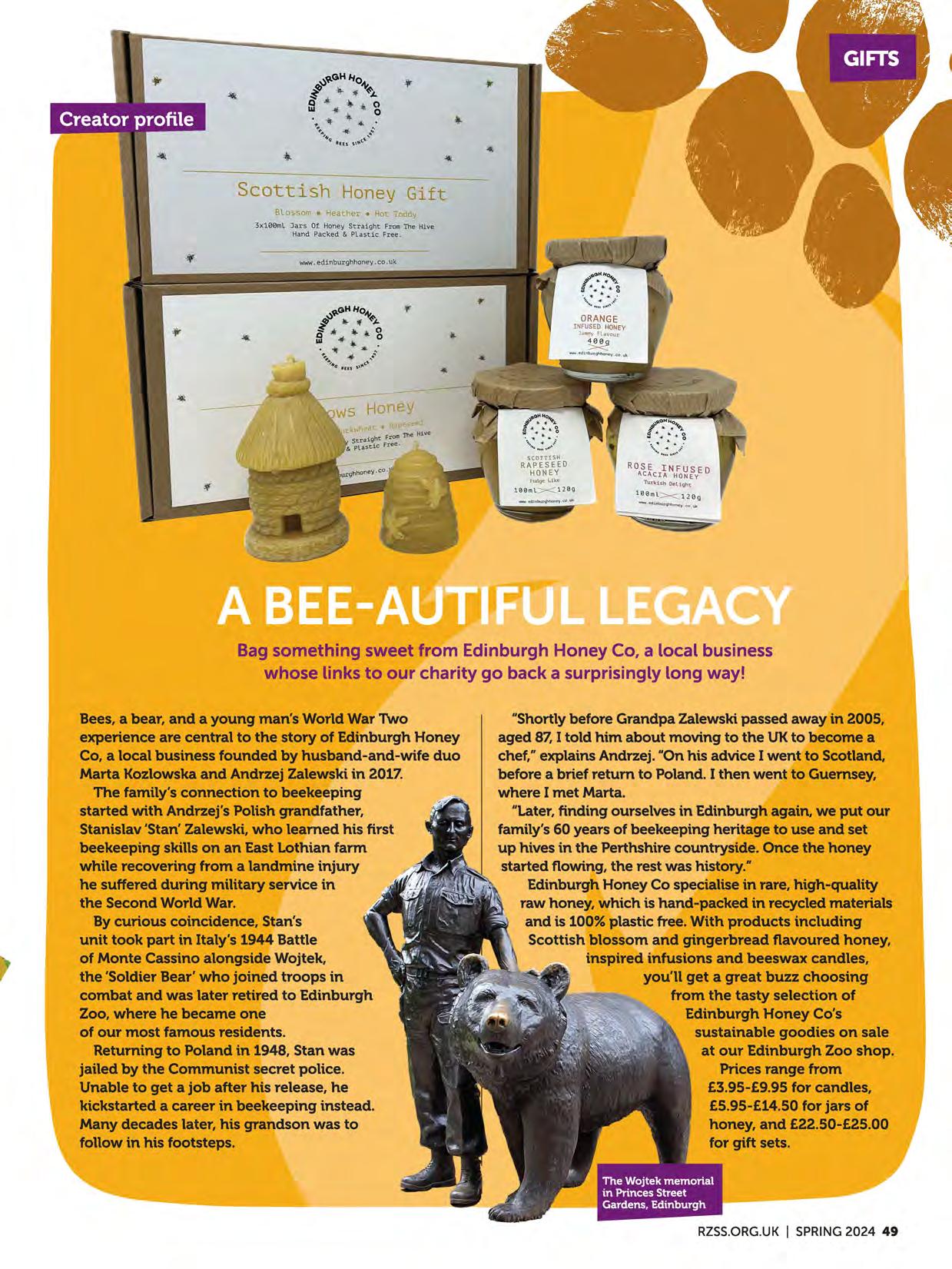
Bag something sweet from Edinburgh Honey Co, a local business whose links to our charity go back a surprisingly long way!
Bees, a bear, and a young man's World War Two experience are central to the story of Edinburgh Honey Co, a local business founded by husband-and-wife duo Marta Kozlowska and Andrzej Zalewski. i.n 2017.
The family's connection to beekeeping started wi.th Andrzej's Poli.sh grandfather, Stani.slav 'Stan' Zalewski., who learned hi.s first beekeeping ski.Uson an East Lothian farm while recovering from a landmine injury he suffered during mi.li.taryservice i.n the Second World War.
By curious coi.nci.dence, Stan's uni.t took part i.n Italy's 1944 Battle of Monte Cassi.no alongside Wojtek, the 'Soldier Bear' who joined troops i.n combat and was later retired to Edinburgh Zoo. where he became one of our most famous residents.
Returning to Poland i.n 1948, Stan was jailed by the Communist secret police. Unable to get a job after hi.s release, he ki.ckstarted a career i.n beekeeping instead. Many decades later, hi.s grandson was to follow i.n hi.s footsteps.
"Shortly before Grandpa Zalewski. passed away i.n 2005, aged 87, I told hi.m about moving to the UK to become a chef," explains Andrzej. "On hi.s advice I went to Scotland, before a brief return to Poland. I then went to Guernsey, where I met Marta.
"Later. finding ourselves i.n Edinburgh again, we put our family's 60 years of beekeeping heritage to use and set up hives i.n the Perthshire countryside. Once the honey started flowing. the rest was hi.story."
Edinburgh Honey Co speci.ali.sei.n rare. hi.gh-quali.ty raw honey. which i.shand-packed i.n recycled materials and i.s100% plastic free. Wi.th products i.ncludi.ng Scotti.sh blossom and gingerbread flavoured honey, i.nspi.red i.nfusi.ons and beeswax candles, you'll get a great buzz choosing from the tasty selection of Edinburgh Honey Co's sustainable goodies on sale at our Edinburgh Zoo shop.
Prices range from £3.95-£9.95 for candles, £5.95-£14.50 for jars of honey, and £22.50-£25.00 for gi.ft sets.
Above:
It took a lot of work to bring Lucu and Dharma together
Below:
Male tiger Lucu
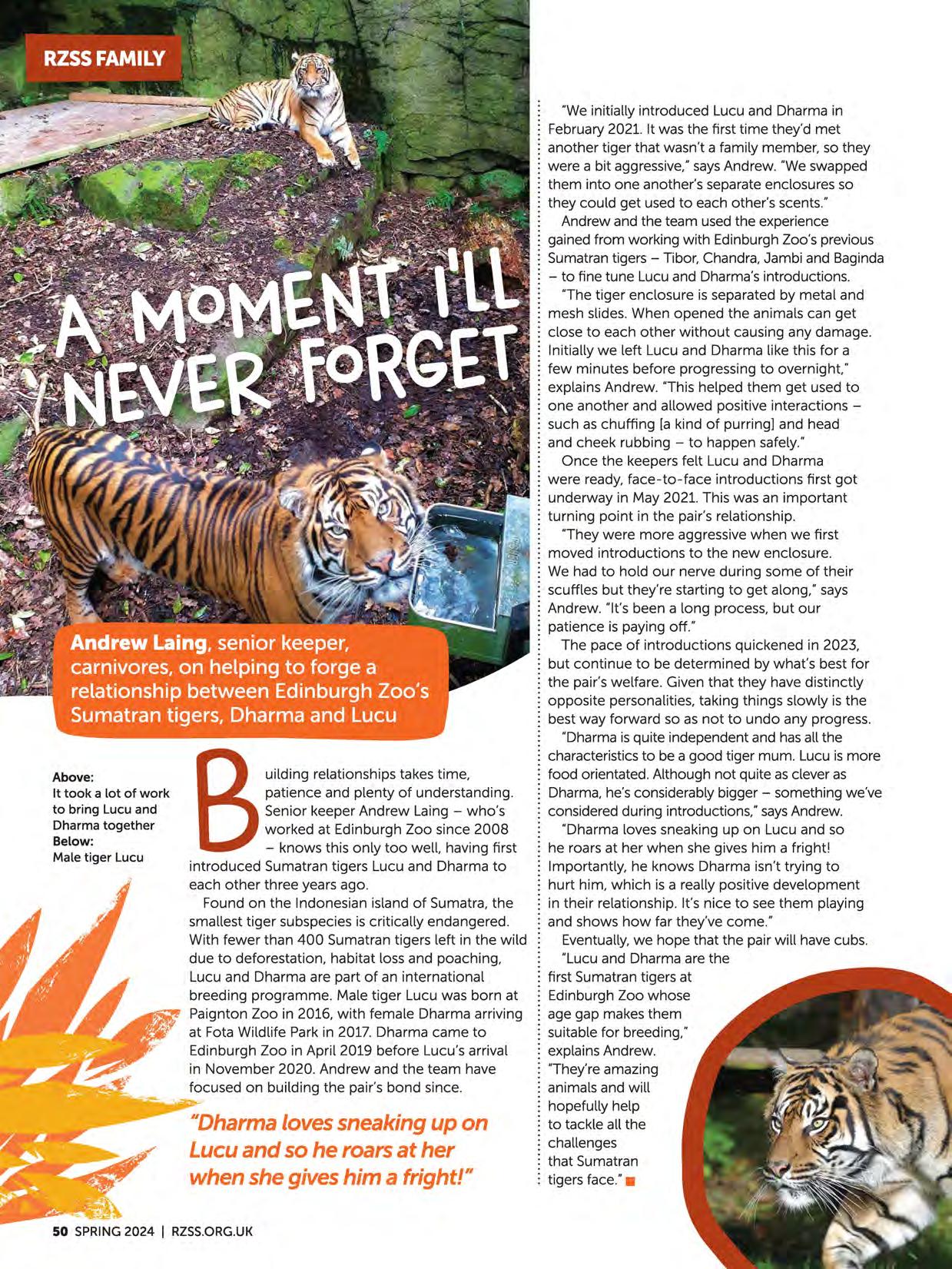
uilding relationships takes time, patience and plenty of understanding. Senior keeper Andrew Laing -who's worked at Edinburgh Zoo since 2008 -knows this only too well, having first introduced Sumatran tigers Lucu and Dharma to each other three years ago.
Found on the Indonesian island of Sumatra, the smallest tiger subspecies is critically endangered. With fewer than 400 Sumatran tigers left in the wild due to deforestation, habitat loss and poaching, Lucu and Dharma are part of an international breeding programme. Male tiger Lucu was born at Paignton Zoo in 2016, with female Dharma arriving at Fata Wildlife Park in 2017. Dharma came to Edinburgh Zoo in April 2019 before Lucu's arrival in November 2020. Andrew and the team have focused on building the pair's bond since.
11Dharma lovessneakingup on Lucuand so he roarsat her when she giveshim a frightr
"We initially introduced Lucu and Dharma in February 2021. It was the first time they'd met another tiger that wasn't a family member, so they were a bit aggressive," says Andrew. "We swapped them into one another's separate enclosures so they could get used to each other's scents."
Andrew and the team used the experience gained from working with Edinburgh Zoo's previous Sumatran tigers -Tibor, Chandra, Jambi and Baginda -to fine tune Lucu and Dharma's introductions.
"The tiger enclosure is separated by metal and mesh slides. When opened the animals can get close to each other without causing any damage. Initially we left Lucu and Dharma like this for a few minutes before progressing to overnight," explains Andrew. 'This helped them get used to one another and allowed positive interactionssuch as chuffing [a kind of purring] and head and cheek rubbing -to happen safely."
Once the keepers felt Lucu and Dharma were ready, face-to-face introductions first got underway in May 2021. This was an important turning point in the pair's relationship.
"They were more aggressive when we first moved introductions to the new enclosure. We had to hold our nerve during some of their scuffles but they're starting to get along," says Andrew. "It's been a long process, but our patience is paying off."
The pace of introductions quickened in 2023, but continue to be determined by what's best for the pair's welfare. Given that they have distinctly opposite personalities, taking things slowly is the best way forward so as not to undo any progress.
"Dharma is quite independent and has all the characteristics to be a good tiger mum. Lucu is more food orientated. Although not quite as clever as Dharma, he's considerably bigger -something we've considered during introductions," saysAndrew.
"Dharma loves sneaking up on Lucu and so he roars at her when she gives him a fright! Importantly, he knows Dharma isn't trying to hurt him, which is a really positive development in their relationship. It's nice to see them playing and shows how far they've come."
Eventually, we hope that the pair will have cubs.
"Lucu and Dharma are the first Sumatran tigers at Edinburgh Zoo whose age gap makes them suitable for breeding," explains Andrew. "They're amazing animals and will hopefully help to tackle all the challenges that Sumatran tigers

No adverts, no plastic -just hours of exploring and understanding the natural world around us. Uncover the wonders of nature, one page at a ti me .
